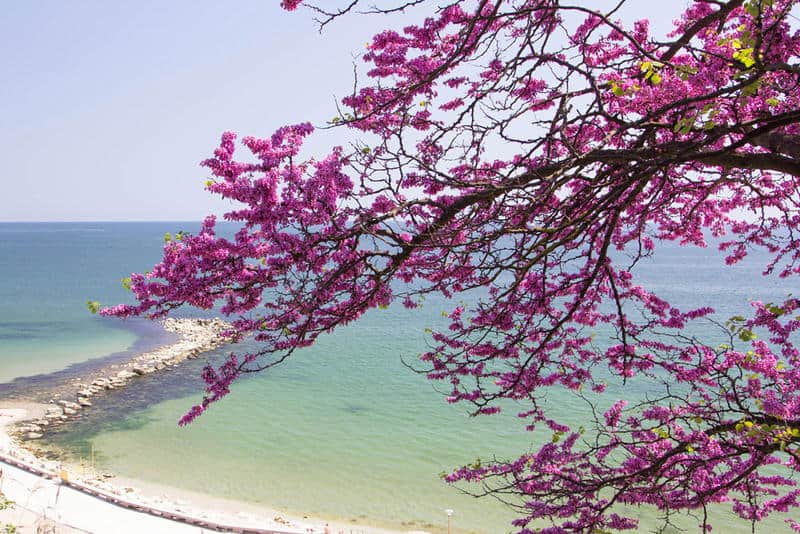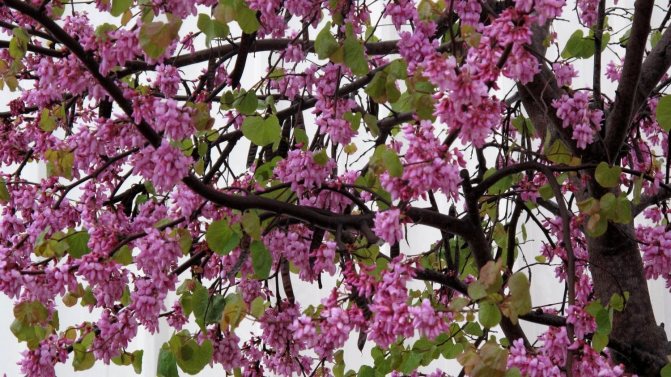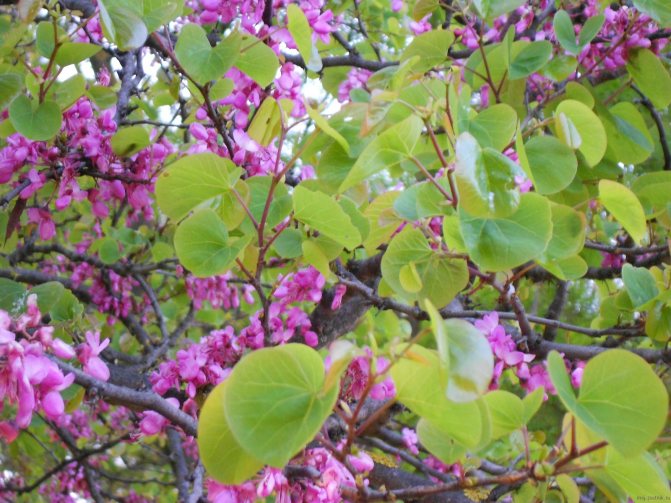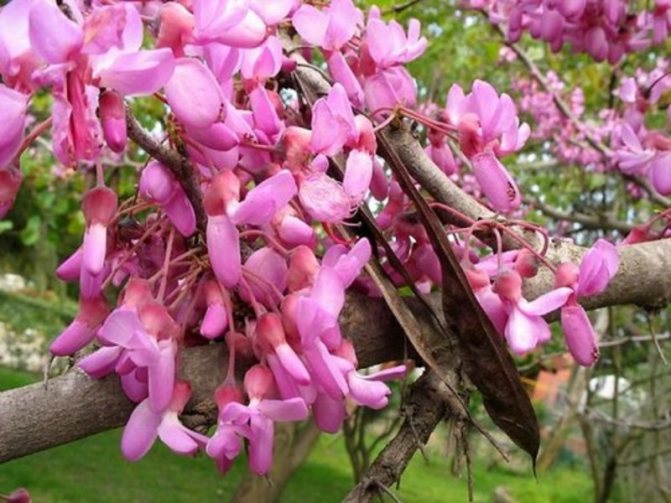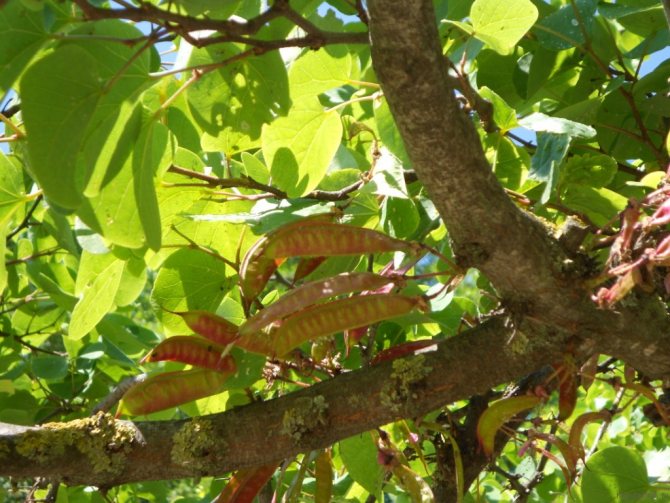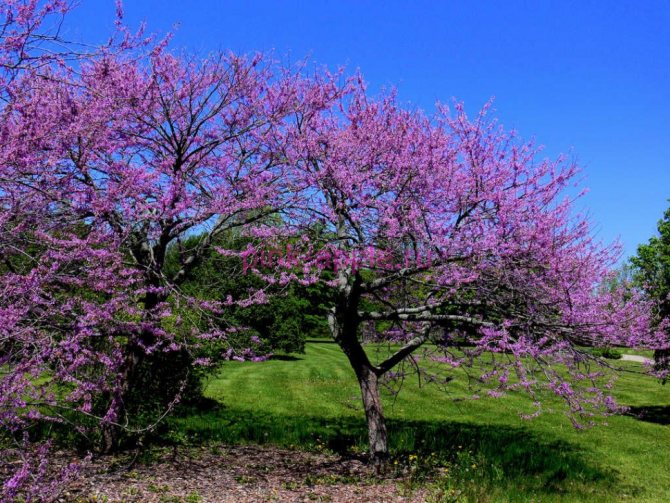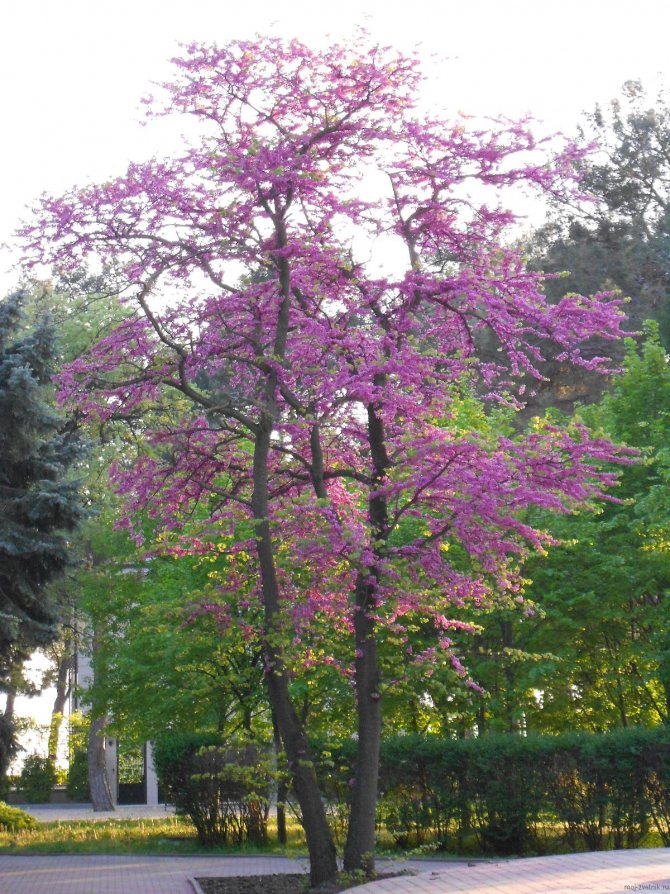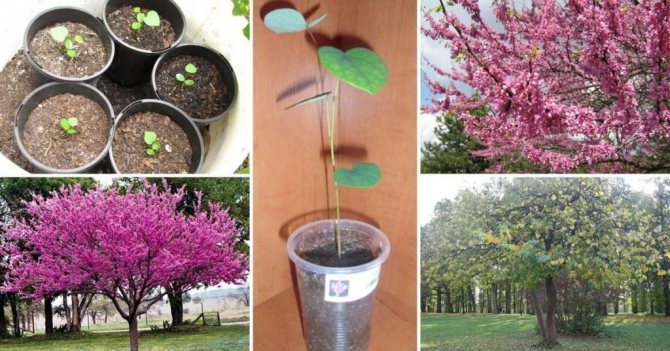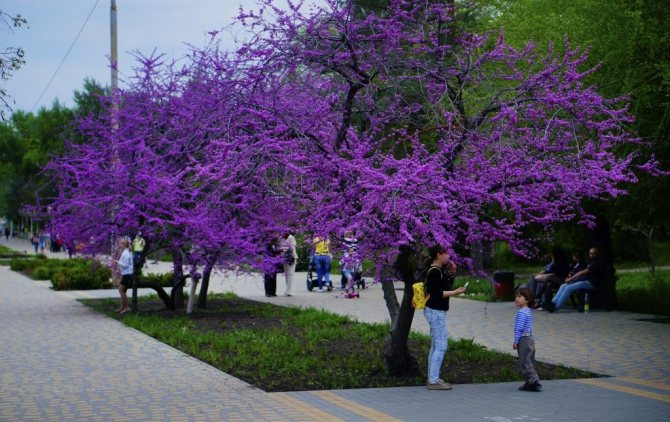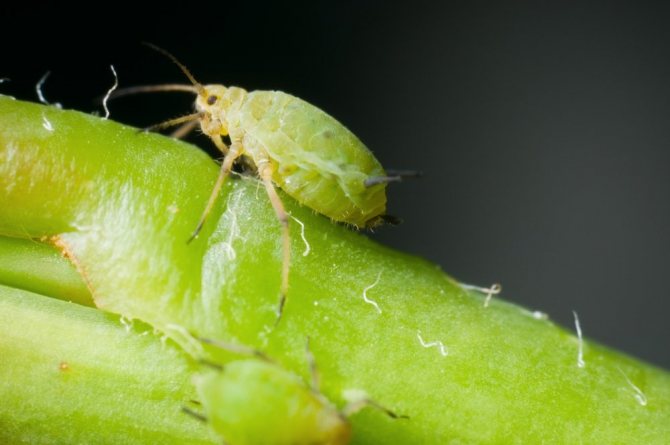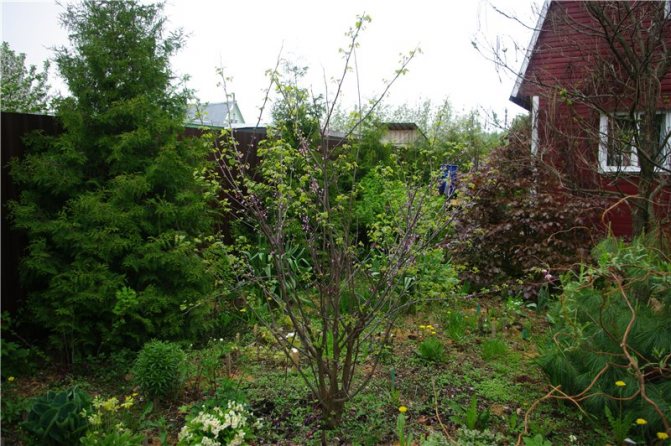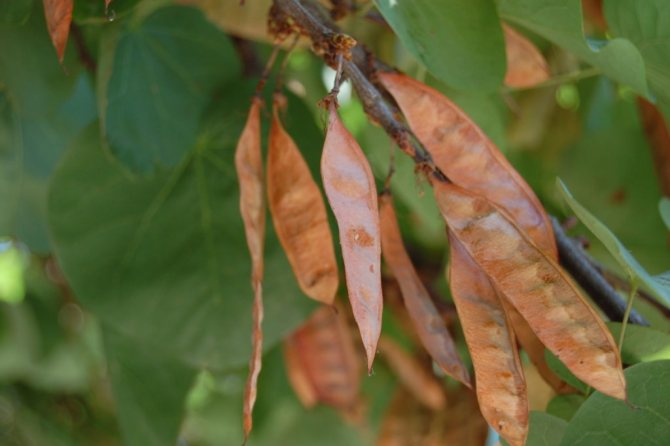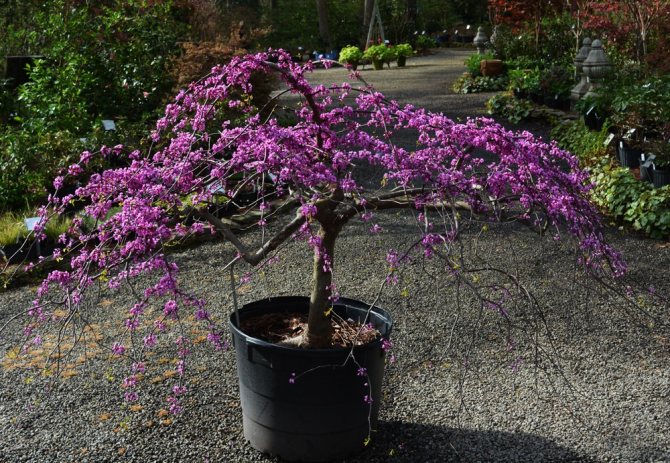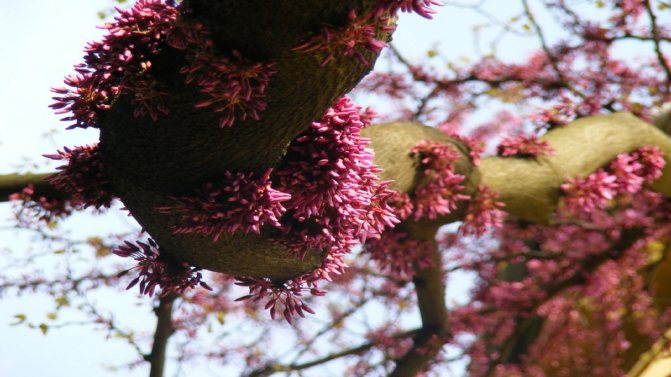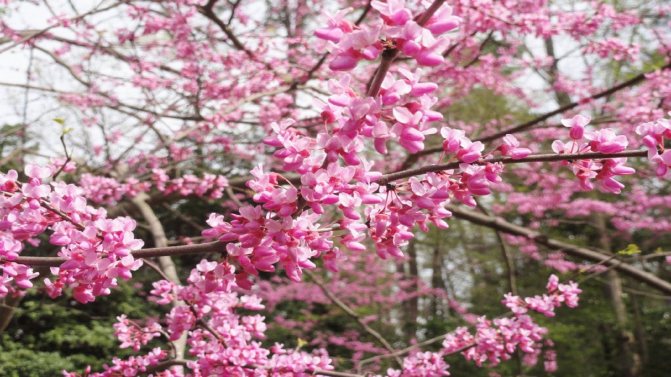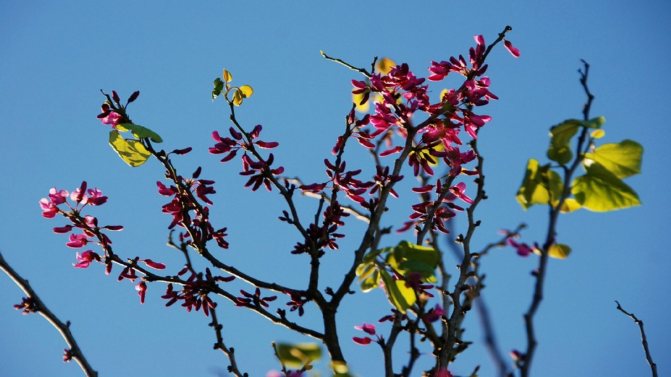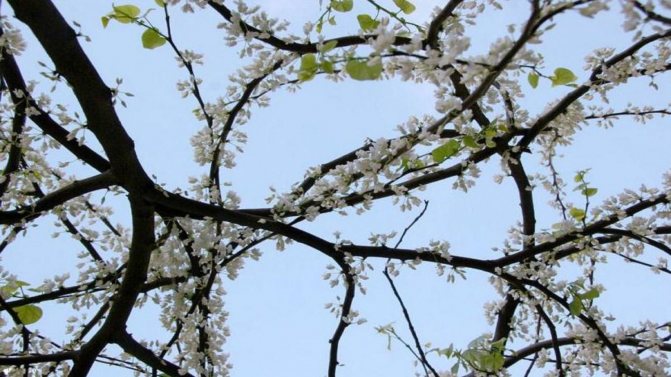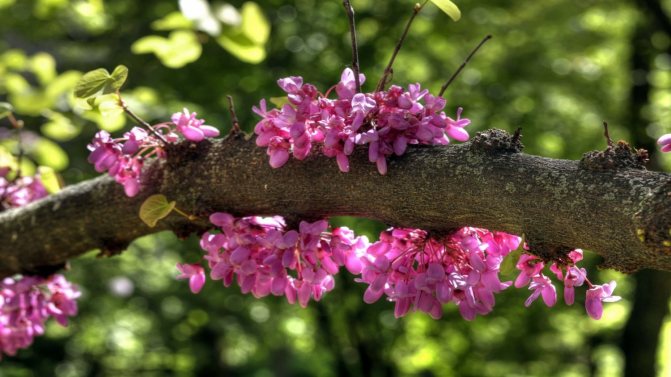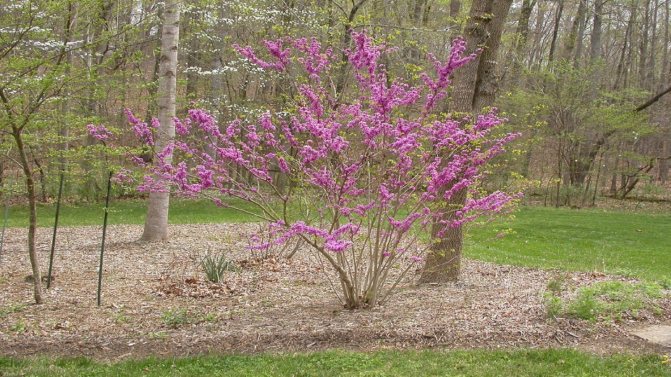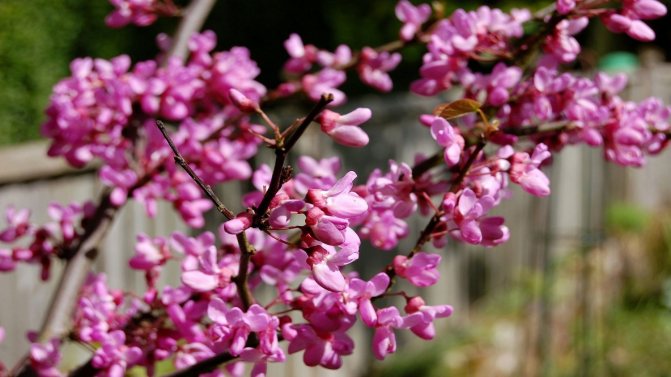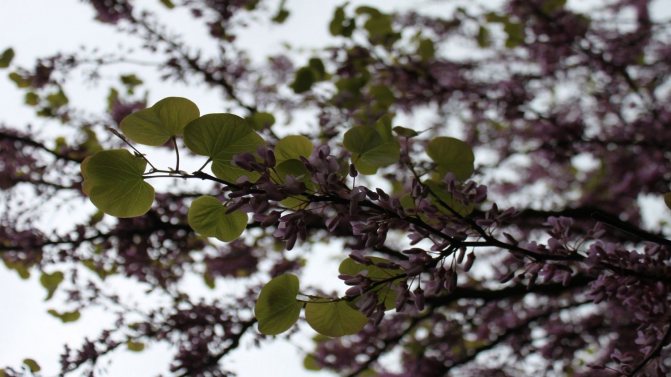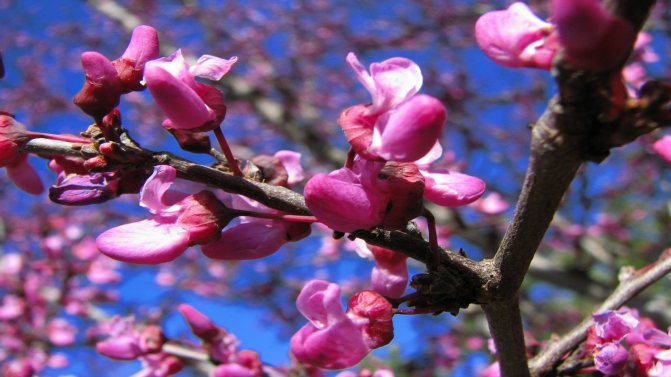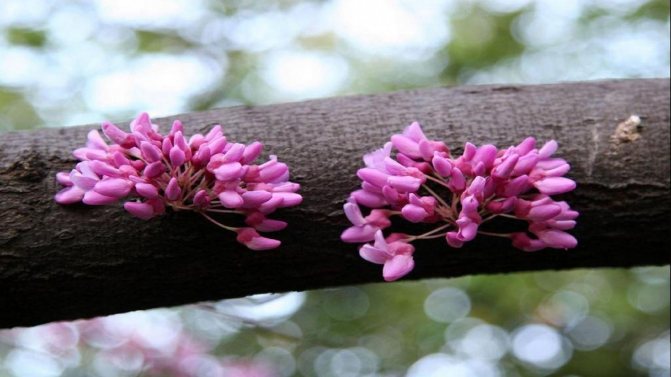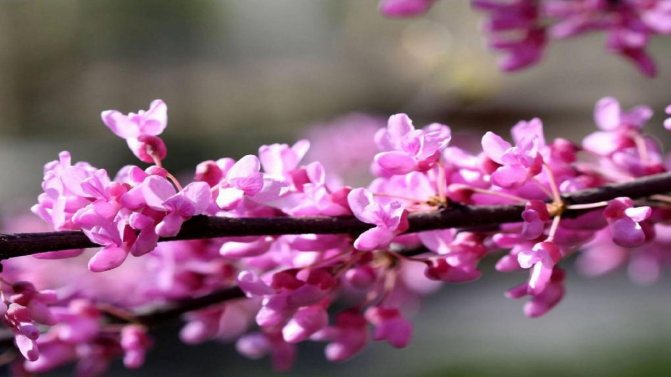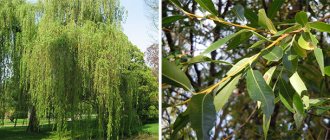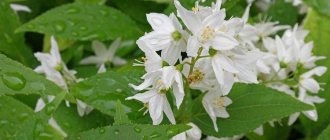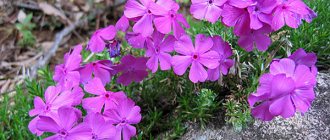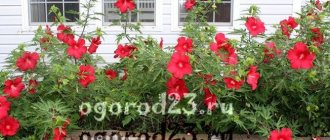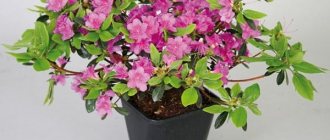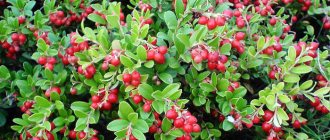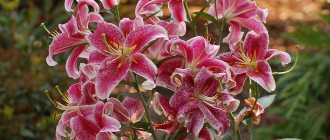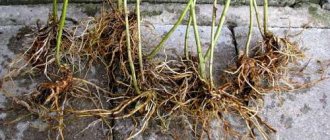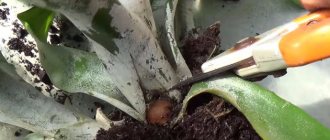The scarlet tree (cercis) is considered one of the most fabulous trees and shrubs, thanks to its unusual flowering, which captivates with its beauty and amazing decorative deciduous varieties.
The genus Cercis (Cercis) from the legume family has 7 species of deciduous trees and shrubs that grow in East Asia, North America, Canada, the Mediterranean and differ in growth form, flower color and size. A characteristic feature of the representatives of the genus is the frequently encountered curved trunk.
In landscape design, the most valued canadian cercis and the heat-loving Japanese scarlet, which is in demand in the landscaping of Asian countries and is an excellent plant for creating a bonsai style.
In natural tropical growing conditions, this species reaches a height of about 3 meters, sometimes higher, but in cold regions it is a short bush that is sensitive to frost and needs shelter. In the climate of the middle zone, the Canadian type of culture is most widespread.
Cercis tree: a description of the appearance
Cercis or scarlet, as it is also called, refers to the genus of deciduous trees. It grows in Asia, North America and the Mediterranean countries.
With proper care, the tree can grow for about 70 years.
In nature, the tree grows up to 18 m tall. The crown is voluminous, looks like a ball. The trunk is curved, thus giving the plant an extraordinary appearance. Leaves are round, less often ovoid. In the summer season, they have a deep green hue, but with the onset of autumn they acquire a yellow color. For the winter, all the plates fall off.
Main types:
- Cercis is European. This species very poorly tolerates severe frosts, therefore it is mainly grown in the southern regions. The flowers are bright pink. They cover all branches abundantly. The height of the tree does not exceed 10 m. The crown is spreading. The leaves are semicircular.
- Cercis Canadian. Differs in frost resistance. A tree grows up to 12 m tall. Deciduous plates are two-colored. Their upper part is green, and the lower one is gray. The flowers are small, light pink. All of them are collected in bunches. Each of them has 5 to 8 buds. At the end of flowering, fruits appear in the form of beans. They stay on the tree for a long time and only fall to the ground closer to frost.
- Cercis Chinese. The tree is tall, about 15 m. The leaves are large. They are heart-shaped. The flowers are purple-pink and appear in May. Cercis Chinese belongs to the group of heat-loving plants, therefore it does not tolerate even small frosts.
The first bloom of purple is observed 4 years after planting. All buds are collected in inflorescences in the form of bunches or brushes. The buds open until the leaves appear. They can be pink, purple, red.
The legend of the Judah tree
Most people ask themselves why the Judas tree is called that. Legend says that in ancient times, the inflorescences of the plant were white and exuded a delicate charming scent. The lush bloom delighted people, weddings were played near the tree, holidays were celebrated and celebrations were celebrated. This continued until Judas Iscariot, who betrayed Jesus Christ, picked up Tersis to commit suicide: he hanged himself on a strong branch of a tree.
All people who disdained the traitor stopped honoring the plant for its beauty and the smell of inflorescences. No one else gathered in the shadow of Cersis for lavish festivities and holidays. People named the plant the "Judas tree" and avoided it. The shrub itself, saddened and disgraced by the touch of Judas, changed its color from white to pink. Since then, the color of the Judas Tree reminds those living today of betrayal, lust for power and hypocrisy.
Scientists think that the name of the plant has created a confusion in the translations. Perhaps Tersis was not called Judah, but the Jewish tree, thus denoting the place of growth - ancient Judea. This explains the fact why the Judas tree got a similar name.
Growing cercis on the site
In order for the tree to be beautiful, it is necessary to choose the right planting site and follow the simple rules of care.
The choice of soil and place for planting
The best area is one that is well warmed up by the sun. Also, the area where the tree will grow should be away from drafts. This is very important, as frosty winds can negatively affect the branches.
The plant loves a substrate that allows water to pass through well. The soil should also have lime in its composition and drainage. If there is clay soil on the site, then a little sand should be added to it. This will prevent stagnant water.
Cercis Canadian is most often grown in the Moscow region. This is due to the fact that he is not afraid of frost.
Plant pruning
This procedure is carried out in the fall on trees that are 4 years old. Shoots are removed by 1/3, and the cut sites are treated with a special agent.
It is also necessary to cut off lateral branches that have the wrong direction and root growth.
In spring, pruning consists of removing frost-damaged shoots.
Potential pests
Cercis is resistant to various diseases and insects. Very rarely, a tree can infect aphids. In this case, all parts are treated with "Confidor", "Aktara" or other similar preparations.
Correct wintering
Before the onset of frost, the twigs must be carefully tied and covered with burlap. The material is fixed at the base with a dense thread.
You also need to pay attention to the soil near the trunk. It is mulched with sawdust or fallen spruce needles.
Using
These "flowering trees" are recommended to be used as an independent decoration in gardens or parkland. It is important to maintain a reasonable distance in planting so that roots and branches can develop freely. The plant looks spectacular against the background of coniferous trees. Shrub forms are suitable for creating hedges. Due to its abundant flowering, it is a good honey plant. Cercis leaves contain beneficial flavonoids that help fight tuberculosis.
>
Rules for growing trees from seeds
This method is often used by gardeners. Subject to all the rules, it will turn out to grow a beautiful and healthy plant that will decorate the flower bed for many years.
Since the beans of the cercis are covered with a thick skin, they must be lightly scalded with water before planting. Then transfer to a small container and fill with sulfuric acid.
Skeletal branches begin to grow only after the root system begins to develop well.
You can also speed up the process of germination of grains by rubbing them with sandpaper. But this should not be done over the entire surface, but only in a small area.
Planting beans is carried out closer to winter. They are deepened by only a few cm. Then they cover the breast with a small layer of peat, spruce branches or fallen leaves.
For thermophilic species, it is better to plant the seeds in containers first. This is due to the fact that such beans germinate in the open field, provided that it is not colder than +30 C.
The container with soil and grains is kept in a cool room. It could be a basement or a cellar. Young plants are planted only after the frost has completely passed on the street.
The seedlings grow very slowly for the first few years. In the year of planting, the shoots that appear dry up. Full growth begins only in the third year of life. If you take proper care of the seedlings, they will add about 20 cm during the summer season.
Plant in the garden
Cercis is usually planted separately from other plants, but among conifers it looks especially beautiful. As already mentioned, when planting a tree, you need to take into account the development of its root system, it should not intertwine with other trees.
There should be no bushes or trees around the cercis within a radius of nine meters.
If you grow shrub species of cercis, then you can plant it in the form of a hedge. Beekeepers know that cericis is a very honey tree, this fact should also be taken into account if you breed bees in your garden. In addition, the leaves of this tree contain special flavonoids that are used in the treatment of tuberculosis.
Cercis: description, types and varieties
Cercis belongs to the legume family (Fabaceae). It is a deciduous tree or ornamental shrub that gets its name from the ancient Greek name for the weaving shuttle, which is associated with the shape of its fruit. 7-10 species belong to the genus Cercis, but many of them do not winter in our latitudes, so here we will give only three of them:
- Certsis European (C. siliquastrum), c. an ordinary or Judas tree is a Mediterranean species that has long been used for landscaping squares in the Caucasus and Crimea. In favorable conditions, it reaches 12 m, and in more northern zones it grows like a shrub. This species was previously confused with the scarlet (Certidiphyllum japonicum), which has showy leaves and is often used in Japanese gardens;
- Chinese cercis (C. chinensis) is not very common in the CIS countries and was hardly worth including in this list, but when you see a flowering tree in Barcelona among a clipped hedge, it is impossible to forget it. Surely there are cultivars that grow confidently in temperate climates;
- Certsis canadensis (C. canadensis) is the most winter-hardy species with a wide spreading crown, 6-10 m tall, originally from North America. There are varieties with purple and light green foliage, as well as drooping branches. The following varieties bloom very beautifully:
|
|
|
|
|
|
|
|
The most frost-resistant is the Canadian one, which allows it to be grown in the European part of Russia. But it should be borne in mind that north of the Voronezh region is too cold for him. The plant begins to freeze slightly and does not bloom annually. If you plant canadian cercis in the climatic conditions of the Moscow region, then it will not please with lush flowering or beautiful appearance. Like many plants from the "risk group", it will not die, but it will not actively grow and bloom.
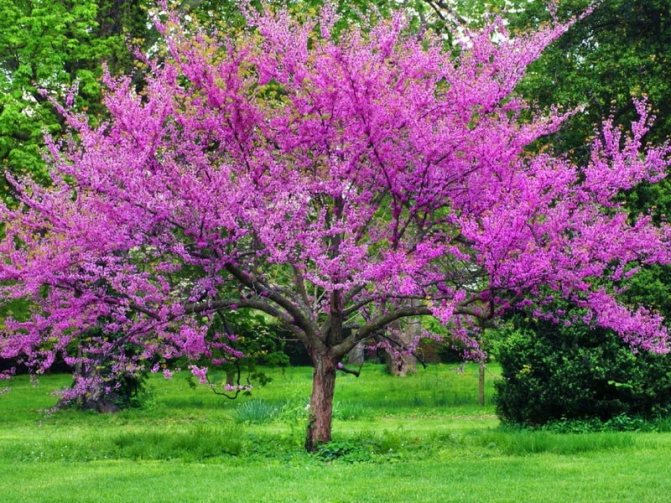
In its habitat, it looks like a tree, reaching twelve meters in height. With a change in conditions, i.e. when grown in colder climates, the appearance also changes: instead of a woody form, a shrub version is obtained. The changes concern not only the life form of the plant, but also the peculiarities of flowering. Flowers become smaller, their number on the branches decreases.
The flowering of cercis occurs in early spring, in the same period as wisteria. At this time, the leaves on the branches have not yet blossomed and the whole plant is covered only with bright pink, less often white flowers, which are arranged in bunches. Flowers are found not only on the branches. They often emerge from dormant buds on the surface of the trunk or thick branches. This phenomenon is called caulifloria in botany and is quite rare.
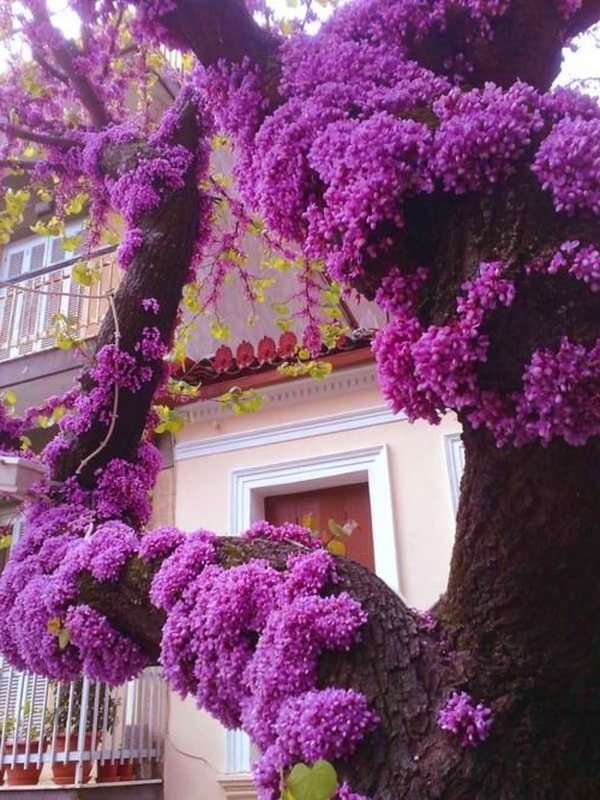

Leaves begin to bloom before flowering ends.They are heart-shaped. In autumn, immediately after the first frost has passed, the leaves of cercis turn red-yellow and orange.
Use in garden design
The Judah tree, when used in garden design, retains its decorative appearance all year round. In spring, gardeners can enjoy the lush flowering of the plant for a whole month, then the foliage, and in winter, pods with beans are pleasing to the eye. A single crop planting would be a good solution. So she will receive enough light and nutrients from the soil to show herself in all her beauty. Certsis also looks great in compositions with coniferous shrubs (juniper, thuja, dwarf pine and spruce trees).
If a scarlet alley is planted, a distance of at least 0.8–1.0 m should be left between the specimens. With further growth, they will not interfere with each other. The plant looks organically in oriental-style gardens.
The Judas tree hedge is thick and attractive, but remember that the plant grows slowly, and therefore you need not overdo it with curly pruning.
In general, cercis will not cause much trouble when growing and will become a real decoration of the garden. At all times of the year, he will rivet the eyes of household members, your guests and just passers-by.
Cercis canadian: planting and care in the open field
Cercis canadensis requires a well-moistened fertile soil and a site protected from the winds. It does not tolerate drought well, so immediately after planting, mulch the soil with organic matter. Prefers calcareous soils. In order for the shrub to adapt well to your climatic zone, we would recommend to carry out the winter shelter of the trunk at a height of 50-70 cm for the first 2 years.
Preparation for the winter of young plants is standard - moisture-charging watering and covering the shoots with dense agrofibre (spunbond, agril, agrotex, lutrasil).
Cercis: propagation by seeds and cuttings
Reproduction of cercis can be carried out by seed or vegetative methods. The seeds germinate well, but stratification is required within three months. To accomplish it, you can use natural conditions. To do this, freshly harvested seeds are sown for the winter or the fruits are left on the tree until spring. In both conditions, the seeds undergo natural stratification. The germination rate of such planting material is quite high.
Cuttings are carried out in the summer. Summer cuttings root quite well. Young shoots are cut into pieces of two or three buds on each and buried in a prepared soil mixture of sand and peat. Until the cuttings take root, the soil should be kept moist continuously.
Rooted cuttings are not immediately transplanted to a permanent place. After the first winter, a significant part of the growth that was during the summer time dries up. But the root system begins to develop at a rapid pace, and as the roots grow, the shoots are restored. If you do not touch the shoots in the center, then the young plant forms a trunk.
To form the crown and activate the growth of lateral branches, formative pruning is performed in the fall, thinning the root shoots. Cercis usually does not need further pruning when it reaches the age of five.
After about two or three years, when young plants reach a height of one meter, they are moved to a permanent place. The place for the cercis is carefully chosen. It should be well lit by the sun, be warm, and the north wind should not blow there. Although partial shade is suitable, flowering will be weaker.
Cercis in landscape design


Cercis or scarlet in landscape design photo
One plant will be a great solo decoration of the site. When planting an alley in a park area, it is necessary to adhere to a reasonable distance between cercis for the normal development of the root system and crown.


Cercis European Judas tree in landscape design photo
Note that trees provide light shade.It is appropriate to combine purple with conifers. With the help of the shrub form of cercis, hedges are formed.
Purple (cercis), care, flowering, reproduction and spectacular varieties
The scarlet tree (cercis) is considered one of the most fabulous trees and shrubs, thanks to its unusual flowering, which captivates with its beauty and amazing decorative deciduous varieties.
The genus Cercis (Cercis) from the legume family has 7 species of deciduous trees and shrubs that grow in East Asia, North America, Canada, the Mediterranean and differ in growth form, flower color and size. A characteristic feature of the representatives of the genus is the frequently encountered curved trunk.
In landscape design, the most prized cercis canadian and thermophilic Japanese scarlet, which is in demand in the landscaping of Asian countries and is an excellent plant for creating a bonsai style.
In natural tropical growing conditions, this species reaches a height of about 3 meters, sometimes higher, but in cold regions it is a short bush that is sensitive to frost and needs shelter. In the climate of the middle zone, the most widespread Canadian type of culture.
Diseases and pests
Cercis is a fairly disease-resistant plant. Shrubs can freeze slightly in cold regions, so they need to be covered. Trees are covered with a thicker layer of mulch to protect the root system. But freezing of branches after winter is not a big problem, since it will be enough only to remove the damaged areas, and the tree / shrub will recover itself. The most important thing is that the roots are not damaged.
The most famous pest attacking scarlet is aphid, which clings to young shoots and thereby sucks out the juice. As a result, we have sluggish leaves and drooping branches.
In the spring, it is necessary to whitewash the trunk, and also, as a preventive measure against anthracnose, to carry out processing (spraying, before flowering) with a weak, one percent solution of Bordeaux liquid.
The most spectacular varieties of canadian cercis
Through the efforts of breeders, a large number of varieties and hybrids with foliage of a spectacular color have been bred, so many forms of the species become a bright accent of the garden throughout the season: in spring, summer and autumn.
Alba group with snow-white blossoms.
"Pink Charm", "Pinkbud" - varieties with pink flowers.
Unusual decorative deciduous variety "Violet Leaf" with young leaves of red color.
"Silver Cloud" - decorative throughout the season, thanks to variegated green and white foliage.
"Whitewater" - a hybrid in the form of a small weeping tree, obtained from crossing "Silver Cloud" and "Ruby Falls" with almost white leaves.
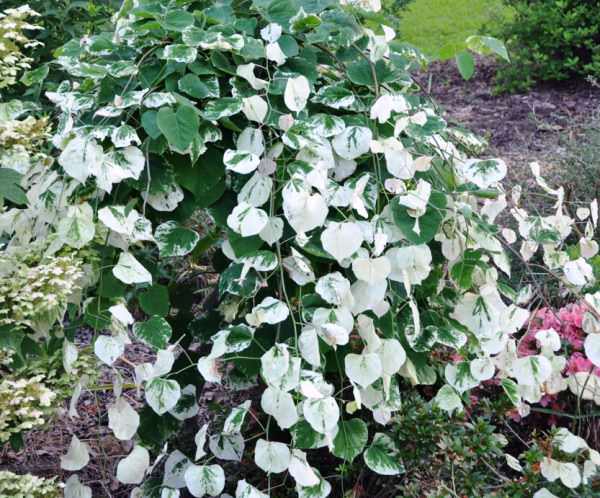

Ruby Falls is an interesting cultivar that also resembles a small weeping willow, as its long shoots grow downward, dropping to the ground like a waterfall. The leaves of this variety are large, purple-brown or burgundy-green.
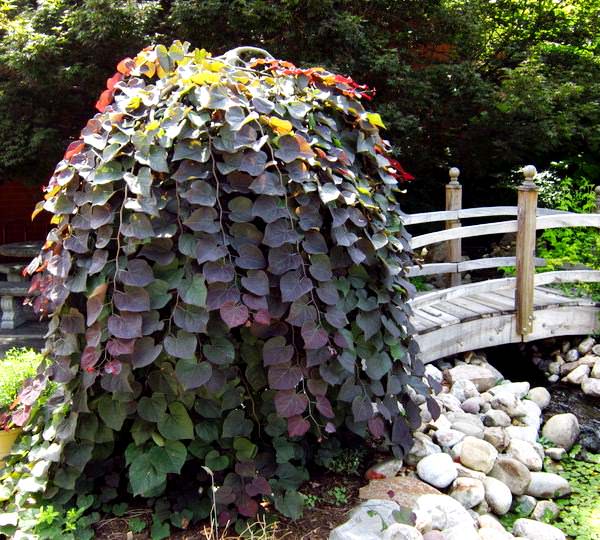

Rising Sun is a delightful new variety, similar in leaf and crown shape to Forest Pansy, but with interesting foliage at the tops of the shoots - emerald green with contrasting gold and orange tints. The tree seems not real, so bright and unusual color of the leaves.
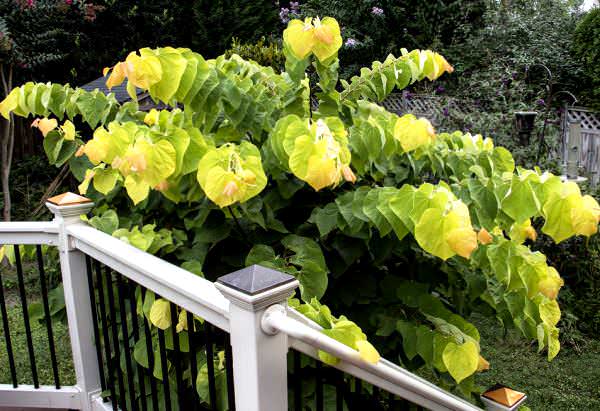

A similar variety "HEARTS OF GOLD" with golden foliage.
"Flame" - a variety with semi-double flowers that do not bear fruit.
"Forest Pansy" is a dark-leaved varietal form of a low tree with a wide, flat crown, burgundy-brown leaves in summer and golden in autumn, very popular among gardeners.
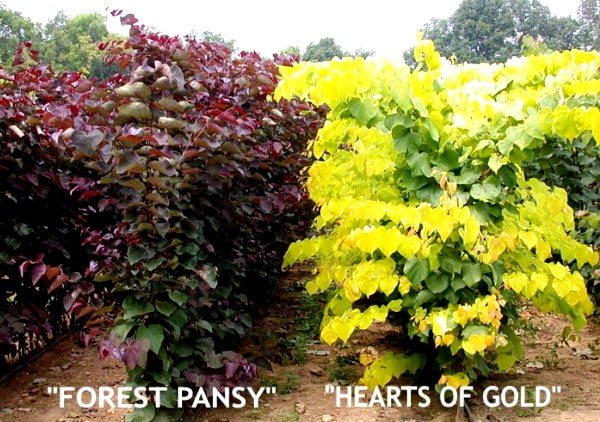

"Little Woody" is a shrub about 3 meters high with small heart-shaped leaves and purple flowers. As it grows, it retains its compact shape, so it does not need pruning.
Views
According to various sources, there are from 7 to 15 species in the genus Bagryanik, the most famous in culture are the following:
C. canadensis (lat. C. canadensis) is widespread in the United States, found in Central Asia and on the Black Sea coast south of Sochi. The species is the most frost-resistant of all scarlet trees, picky about the composition of the soil and its moisture. Ts. Canadian is a tall tree with a tent-shaped crown, black-gray bark, young shoots are red. The leaves are large (up to 16 cm), gray-green, pubescent below. Flowers 1.2 cm in diameter are painted in light pink or lilac pink. Flowering occurs in April-May, and fruit ripens in September-October. Beans up to 10 cm long.
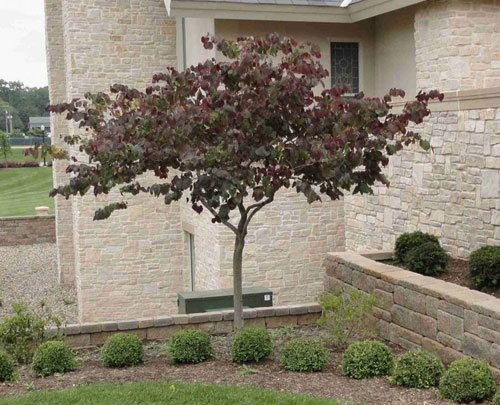

Single planting cercis
On the basis of the species, many varieties have been bred, especially decorative ones:
C. Canadian "Forest Pansy" (Latin C. canadensis ‘Forest Pansy’) and C. Canadian “Ruby Falls” (Latin C. canadensis ‘Ruby Falls’). The trees of these varieties have leaves of a chic burgundy-purple color. And Ruby Falls is also weeping branches. Also popular is the 'Hearts Of Gold' variety, which has an excellent light green color of foliage. Ts. Canadian "Pink Pom Poms" (Latin C. canadensis ‘Pink Pom Poms’) is distinguished by pink double flowers. The C. Canadian species has been in culture since 1641.
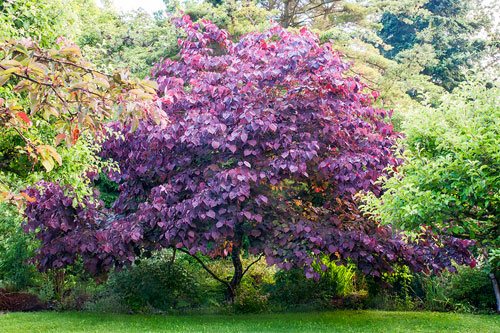

C. Canadian "Forest Pansy" (C. canadensis ‘Forest Pansy’)
Ts. Chinese (lat. C. chinensis) - the species is distributed in the central part of China. The foliage is almost rounded. Flowers up to 1.8 cm in diameter. Flowering starts in May. Fruiting occurs in September. Plants often develop in the form of tall shrubs, less often trees, and grow up to 15 m.
Popular decorative varieties:
Ts. Chinese "Shirobana" (Latin C. chinensis ‘Shirobana’) with white flowers and Ts. Chinese “Avondale” (Latin C. chinensis ‘Avondale’) blooming with bright pink-purple flowers.
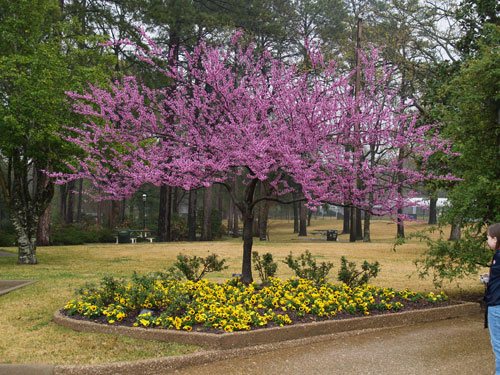

Color combinations
Western C. (Latin C. occidentalis) is a species native to the southern United States, represented by low trees or shrubs. Blooms in May with small pink flowers. In the fall, the leaves may turn red rather than yellow like in other species.
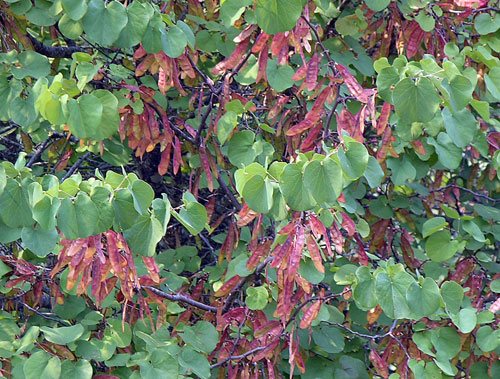

Fruit ripening of C. western (C. occidentalis)
C. European (lat. C. siliquastrum) is a more thermophilic species common in the Mediterranean, Asia Minor, Lebanon and Syria. It also grows on the Black Sea coast, in the more northern regions it develops in the form of a bush. In our climate, it freezes and blooms poorly, which affects the decorative effect. Trees grow up to 10 m, their crown is spreading, dark bark. Leaves up to 8 cm long. The flowers are large up to 2.5 cm, the petals are pink-purple. Trees develop slowly: in 5 years they grow only up to 1–1.5 m. Flowering occurs in early May, fruiting in September. The species has been cultivated since 1813.
An interesting fact: in the western countries, C. European is called the Judas tree. According to legend, after the death of Judas, the flowers of cercis turned purple from white. More like the truth is not the connection of the plant with Judas, but the name of the area in which the scarlet is very widespread and from where it was brought to Europe, we are talking about Judea.
Growing features
The culture is quite whimsical and needs attention. In comfortable conditions, the life span is 70, and sometimes even a hundred years, but the first years of cultivation are decisive.
In theory, scarlet is resistant to frost, but in areas with severe winters and too low temperatures, it is extremely difficult to grow thermophilic species. In this case, it is better to choose a Canadian or European cercis for planting, which can withstand temperatures well up to -28-30 ̊С.
Planting cercis
Buy seedlings from nurseries with a closed root system that allows for planting in spring and summer. Trees with open roots do not root well and often die. Choose a place that is warm and protected from wind, which can cause plantings to freeze in winter. The culture also needs good lighting, since abundant flowering is possible only in full sun or light partial shade.
Cercis canadensis grows well on fertile, neutral or slightly alkaline, moderately moist soils with good water permeability. Does not tolerate heavy and damp substrates.
When planting, it is useful to add 3 parts of compost and a little lime, which are mixed with the soil from the planting pit. After the procedure, the plant is watered abundantly and the soil is not allowed to dry until the seedling takes root.
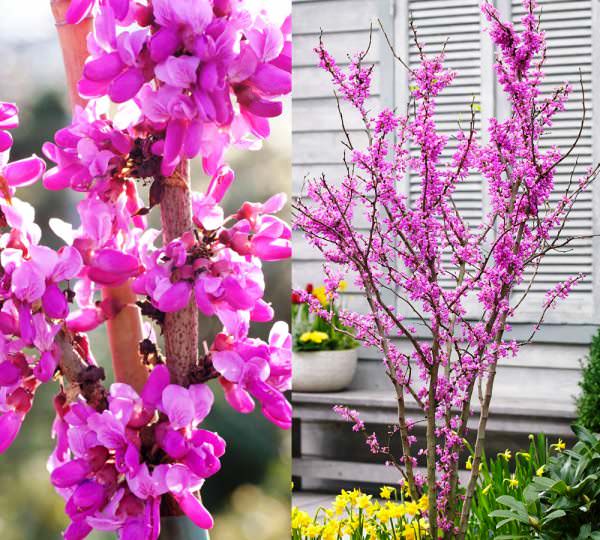

The first rather poor flowering usually occurs when the plantings reach three years of age, and their root system gets stronger, and the tree is abundantly covered with flowers when it reaches five years of age, when the crown becomes sufficiently branched.
Frost resistance
In the first two to three years, the ground part of the seedlings can completely freeze out, therefore it is very important to provide the plant with agrotextile, jute cloth, straw mulch or spruce branches before winter frosts, and lay out a thick layer of compost or dry leaves at the base of the trunk. Flower buds, buds and flowers are damaged by frost at -3 ° C.
Caring for cercis
During the growing season, the plant requires regular watering as the substrate dries up, it is resistant to short-term drought for several days, the Bagryannik produces a deep root system and is able to provide itself with the necessary nutrients, so it does not need any additional feeding. It is enough to mulch the soil around the roots with compost once a year in spring.
Read also: Planting garden azaleas, care and reproduction
An important part of caring for cercis is annual sanitary pruning, which helps to improve its health and appearance. However, the plant reacts poorly to a strong shortening of shoots. In the spring, old, diseased and damaged branches are removed. The cut sites are covered with garden pitch. It is also necessary to thin out thickened shrubs to give access to light and air.
In the fall, you can correct the shape of the crown, but not more often than once every 2-3 years. If the bushes form basal growth, then it is better to remove it. To give the purple bush the shape of a bush, its branches and trunk are cut in half when planting.
Reproduction methods
The Judas tree propagates by seeds and cuttings. The first method is quite successful, but it does not guarantee that the varietal characteristics of the mother plant will be obtained.
Reproduction of cercis by seeds
Before sowing, the seeds need cold stratification, so they should be collected in late autumn from ripe pods, but before they are opened, then dry the seeds at room temperature. Store in container at 1-5 ° C in refrigerator for 4-8 weeks. Seeds can be cold stratified naturally if left outside in winter.
Unlike bean seeds, which germinate easily a few days after planting, scarification seeds have a hard layer that needs scarification. Take a small knife and scratch the shell or file it down. You can also soak in boiling water for half an hour before planting.
After processing, the seeds are sown in pots filled with a mixture of universal soil and perlite to a depth of 2-3 cm. At the bottom there should be a layer of expanded clay for drainage. Cover the pots with transparent foil. Germination temperature 17-20 ̊С. The soil should be moderately moist at all times. As soon as sprouts appear, the cover is removed, the pots are placed in a place with bright diffused light.
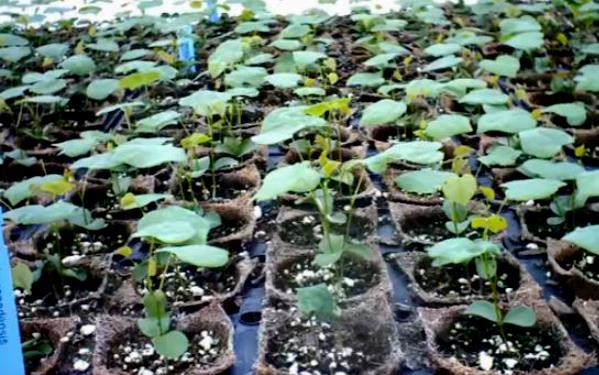

The grown seedlings after the last frosts can be gradually accustomed to the open air, however, plants can be planted in open ground only the next year.
Propagation by cuttings
The propagation method with cuttings is more difficult. Harvesting of planting material is carried out in the middle of autumn, cutting off cuttings 20 cm long, then they are placed in wet sand, deepening by 3 cm. It is necessary to monitor the moisture content of the sand throughout the winter. Cuttings are planted in open ground at the end of March.
Growing problems
Judah's tree is susceptible to fungal diseases, so it is worth using preventive treatment and removing the diseased parts of the plant.
Most often, verticillary wilting develops - a fungal disease of the root system, which is manifested by wilting and yellowing of the leaves, the death of shoots. Leaves after falling and cut branches with symptoms of the disease must be burned. Of insects, it is mainly affected by caterpillars.
Cercis, scarlet, scarlet, Judas tree is a deciduous shrub or a tree of the legume family, which retains its decorative effect throughout the year. These unique plants can be found in the Mediterranean, Asia, and North America.
Quivering heart-shaped leaves with smooth edges and embossed veins on the surface are attached with petioles and are located on the branches in a spiral manner. The pale green shade of the leaves darkens by mid-summer, and in the fall it becomes yellow, crimson.
The life span of a plant is from half a century to 70 years. The cercis tree reaches a maximum height of 18 m. In the first year, its branches are covered with reddish smooth skin. In young shoots, it is olive-brown or grayish, and on adult branches and trunk it coarsens, becomes black-brown. The trunk often grows twisted, as if curling.
Growing
Location
For growing and caring for cerscis, you need a well-lit place, protected from northerly winds. It can also develop in partial shade. The land must be fertile, well-drained, lime must be present in it. In dense garden soil, you need to add a little sand and loosen it well with a rake.
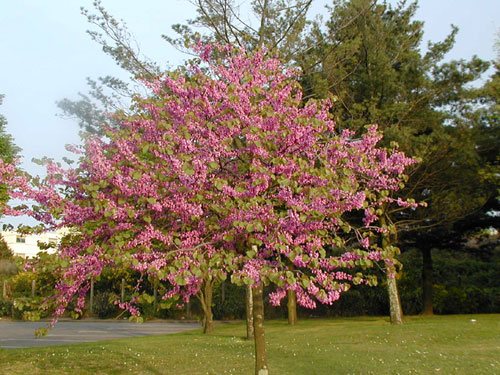

C. European (C. siliquastrum)
Grooming and pruning
Cercis loves good watering in the first years of life. The trees are then watered sparingly. It is not necessary to make additional fertilizers: all the elements necessary for development are obtained by the crimson from the soil, water and air on its own. In the spring, the trunk must be whitewashed. For the prevention of anthracnose, you can spray with a weak solution of Bordeaux liquid before flowering. The trunk circle is mulched, the layer is increased for the winter. Wrap up young trees.
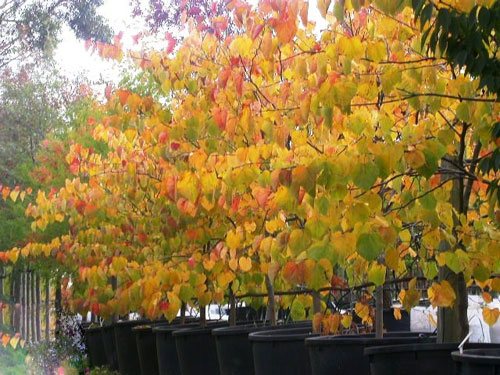

Scarlet in autumn
In autumn, formative pruning is carried out: branches can be shortened by a third (if necessary), root growth and unnecessary branches on the trunk are removed, as well as those growing in the wrong direction. The scarlet grows slowly, therefore, in the third or fifth year of life, it is formed, and then practically not cut off. In early spring, sanitary pruning is carried out, in which frozen branches are removed.
Caulifloria cercis
Reproduction
Cercis propagates by seeds and vegetatively (cuttings). Seed germination is good. To grow cercis from seeds, they can be collected in the fall and stratified within three months. The seeds are soaked for 24 hours in very hot water (use a heat-retaining container). During this time, they swell and increase in size. Then they are placed in a refrigerator, then taken out again and soaked in boiling water. This procedure is repeated three times. In spring, seeds are sown (temperature should be 15-20 ° C). In order not to carry out such a complicated procedure, you can collect the seeds in the spring. In this case, they will undergo natural stratification. Seed germination is also good.
For the first few years, the plants grow slowly; by autumn, the aboveground part of the plants may die off. Only by the third year will the shoots begin to grow steadily. Skeletal branches will begin to develop as soon as the root system reaches a certain size: first, the roots grow down to 1 m, and then horizontally.
Three-week-old crimson sprouts
Reproduction of crimson by cuttings is also quite successful. Cuttings are harvested in the fall: they take a part of the shoot (2-3 internodes) up to 20 cm long, drop it in a box with sand, in winter they make sure that the sand does not dry out. In mid-March, shallow pits up to 10 cm are prepared, the end of the cutting is treated with a growth stimulator, the cuttings are planted at an angle of 45 °, the planting is watered and mulched.
Decorative flower bed
Amazing flowering of cercis
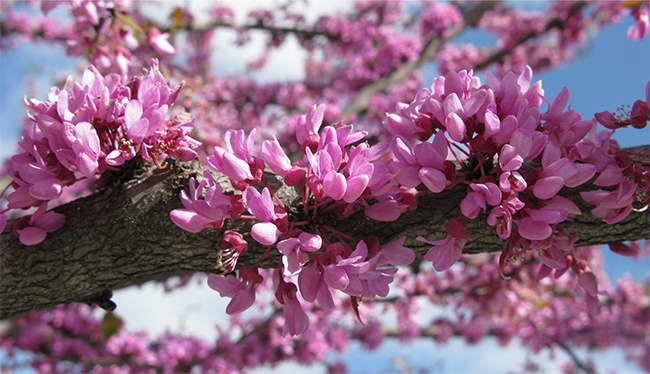

How the canadian scarlet blooms photo
An interesting phenomenon called caulifloria is inherent in the plant. So, inflorescences are formed not only on the branches, but also on the trunk itself. Shoe-like pink flowers are collected in dense brushes or bunches. The flowering period occurs at the end of April-May and precedes the blooming of the leaves. It seems that hundreds of moths have perched on a bare tree. The subtle, subtle scent of flowers attracts insects. Savoring the pollen, they reveal the melliferous "talent" of cercis.
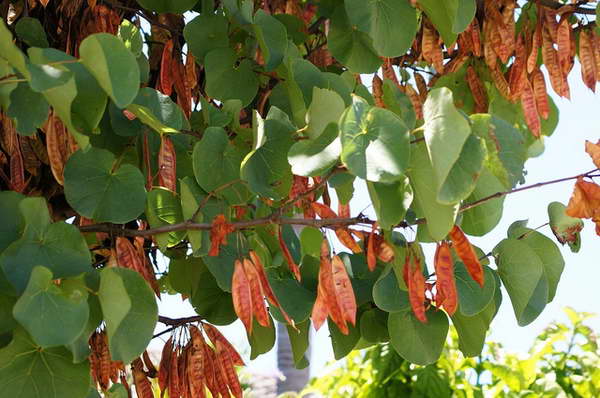

Cercis fruit photo
After the flowering of the scarlet, clusters of pods up to 10 cm long are formed, which hang on the tree until next spring. The fruit is flat, the surface is glossy, there are 4-7 oval dark brown beans inside.
When to expect bloom
Surprisingly, the first couple of years of life, the aerial part of the cercis almost completely dies off during the cold season. The Judah tree grows slowly, only by three years a powerful root system will form and the first buds will appear. A full, lush flowering should be expected around the 5th year, when the crown becomes quite dense.
Bloom
The scarlet is irresistible at the time of its flowering, which begins in April-May, when almost completely the entire tree, and often the trunk, is covered with magnificent fragrant flowers collected in bunches of bright pink, purple, lilac, lilac, purple or white color. This is an unforgettable sight. The development of flowers directly on thick branches and trunk is called caulifloria in botany and is more typical for some tropical crops.
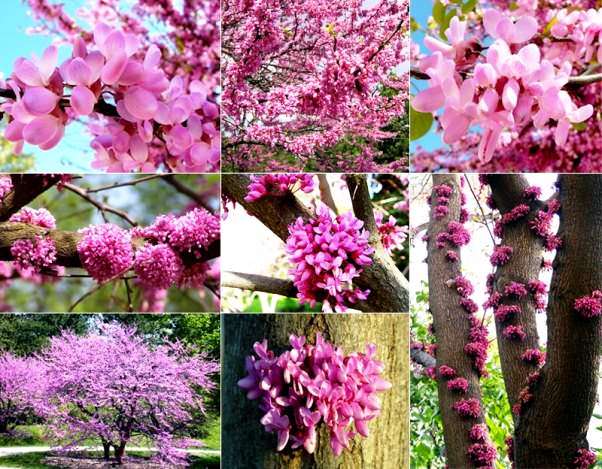

The flowers of the plant are edible, have a sweet and sour exotic taste and can be used in cooking. Flowering ends simultaneously with the appearance of leaves. At its end, in place of flowers, long bean-like, dry, brown and flattened pods are tied, the seeds in which ripen at the end of summer.
Growing cercis from seeds
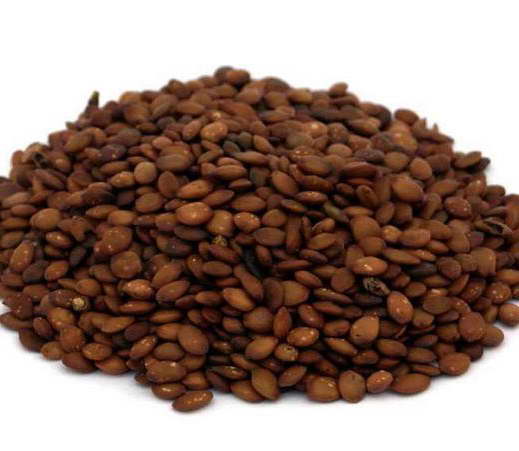

Seeds of cercis european photo
Cercis beans have a dense shell through which the sprout is not able to break through. Therefore, before sowing, they must be scarified (scalded with boiling water, kept in a solution of sulfuric acid) or stratified (held for 2-3 months at temperatures from 0 to +4 ° C, for which the vegetable section of the refrigerator is perfect). If sown in the fall or the crimson beans overwinter in pods on a tree, they will stratify naturally and the need for additional processing will disappear.
Sowing in the ground
So, cercis seeds can be sown directly into open ground. We just dig up the area, break up the breasts and level the soil. We close several beans to a depth of 3-4 cm at a distance of 15 cm from each other. We thin out the seedlings and plant them at our own discretion; the distance between adult plants should be at least 2 meters.
It is advisable to cover winter crops with peat or dry leaves; in very cold regions, it should be additionally covered with spruce branches. Keep in mind that the seeds of heat-loving varieties will sprout if the temperature in winter does not drop below 3-4 ° C with a plus sign, they are only suitable for regions with a southern climate.
Suppose spring sowing, the outside air temperature should be 15-20 ° C.
Growing cercis from seeds at home
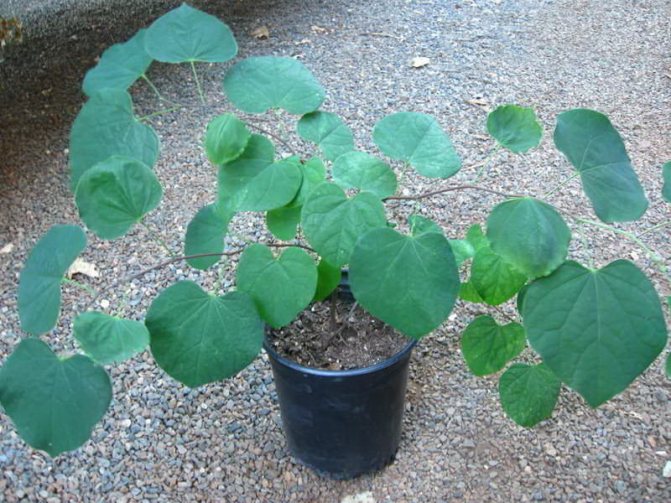

Cercis from seeds at home photo
You can plant scarlet seeds even in an apartment, start sowing from the end of February, be sure to follow the recommendations for scarification or stratification.
- You can sow one seed at a time into the cells of the seedling cassettes, filling them with nutritious loose soil.
- Embedding depth 0.5-1 cm.
- Place crops on a southern or eastern window sill, provide them with regular moisture, preferably cover with foil or glass until shoots appear. Then remove the shelter.
- The grown seedlings are transferred into separate pots, and then planted in the garden for growing.
- In the fall, the seedlings need to be dug up again and transplanted into pots in order to keep them until spring in a cool, well-lit room.
- Next spring, it will be possible to plant plants in the garden; in the fall, be sure to build a good shelter for the winter in order to protect them from freezing.
Information for beginners
- Cercis loves sunlight, warmth. In partial shade, the caesaris will not die, but it will not please you with its lush flowering.
- In the area where you want to plant an ornamental plant, there should be no drafts, the soil should contain a sufficient amount of nutrients, and watering should be moderate, but regular.
- When planting is complete, the soil must be mulched with organic matter.
- Cercis does not have many preferences, one of them is calcareous soil.
- In order for the seedling to acclimatize, it is recommended to cover the bole for the winter for two years after planting. During the first years, the plant will not grow quickly, this is considered normal.
The shrub looks impressive both growing alone and in tandem with others. In southern latitudes, hedges with the participation of cercis are not uncommon.
Vegetative propagation of cercis
Crimson cuttings
Cercis or scarlet can be grown from a cuttings.
For cold regions, we harvest cuttings in the fall: cut off a part about 20 cm long from a 2-3-year-old shoot (2-3 internodes are required) and plant in a container with wet sand, store in a cool room. We maintain constant soil moisture. Transplant outdoors in early to mid-April. It is advisable to treat the lower part with a growth stimulant. Make the planting holes 15-20 cm deep, lay a drainage in the form of coarse sand on the bottom, pour some earth, set the handle in the center, tilting at an angle of 45 °, completely fill the hole with earth, do not press hard with your palms at the surface and water.
In the south, the procedure is even simpler: in the fall we cut the cuttings and immediately add them to the garden bed. The seeding depth is 10-15 cm. Before frost, they will have time to put down roots, even if the upper part freezes, a young shoot will still grow in spring.
Reproduction by shoots and layering
Mature trees and bushes periodically release basal processes with their own root system. They are separated mainly in the spring before the start of active sap flow. We plant it in a permanent place, preparing the hole according to the size of the root system.
Shrub cercis is still propagated by layering. It is necessary to bend the side shoot to the ground, fix it with a bracket or a hairpin, make a shallow cut with a knife at the point of contact with the soil and sprinkle it with a bump of earth (leave the top of the branch free), which must be periodically moistened. Next season, we separate the plant from the mother bush and plant it according to all the rules.
Plant propagation
With your own hands in the open ground, the tree can be propagated by seeds, layering and cuttings.
Propagation using seeds
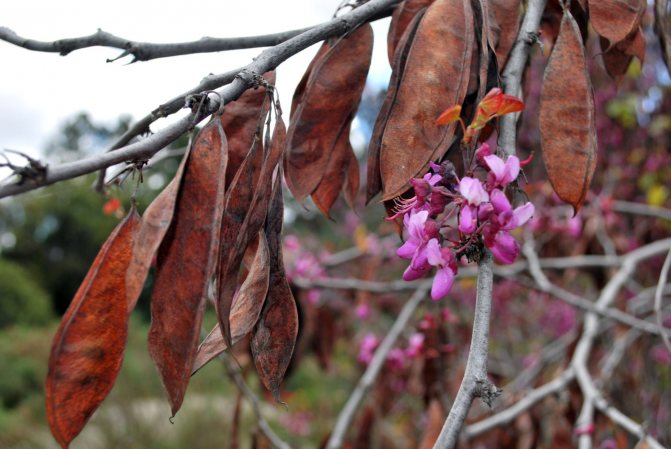

Since cercis belongs to legumes, its seeds must be scarified before planting. This procedure can be replaced by another: pour over the seeds with boiling water or hold them in a container with hydrochloric acid. This will subsequently help the future sprout to break through the shell.
At home, seedlings of cercis are not grown, it is customary to plant seeds immediately in the ground on the site. On top of the plantings, you need to lay dry leaves in a dense layer or cover the garden with coniferous spruce branches. When planting seeds in the ground, you need to keep in mind that if you have planted heat-loving varieties, then in winter at temperatures below five degrees, the seeds may die.
Propagation using cuttings
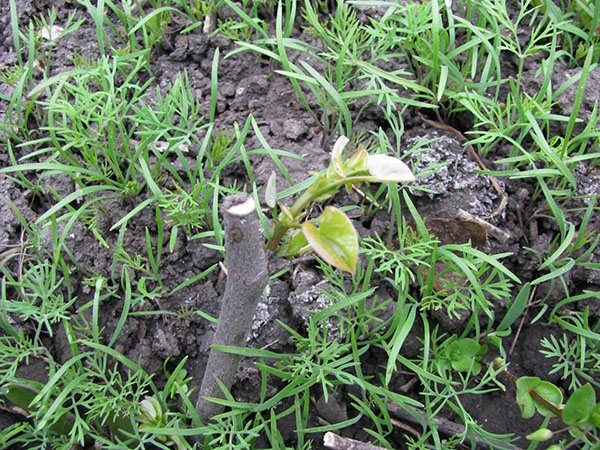

You need to prepare cuttings in advance, it is best to do this in the fall. You can do it this way: cut off a two-year-old healthy shoot with at least two buds. After that, it is imperative to root the stalk in the open field by digging it in at an angle to a depth of fifteen centimeters.
Before frost appears, the cutting should take root, thus surviving the winter. If the aboveground part freezes in winter, a new sprout will appear from the roots in spring.
Reproduction by layering
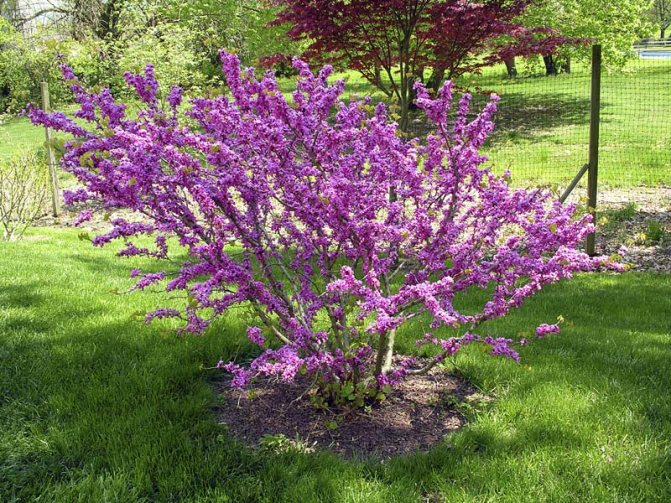

In this way, the tree is propagated in the spring.Periodically, layers appear near the root system of the tree. These cuttings can be neatly separated from the parent tree and planted separately. They usually develop quickly, as they already have a well-developed root system.
While the plant is young, systematic care is required for it, after it gets stronger, you can not worry about the health of the tree.
Types of cercis scarlet with photos and descriptions
Cercis European Cercis siliquastrum
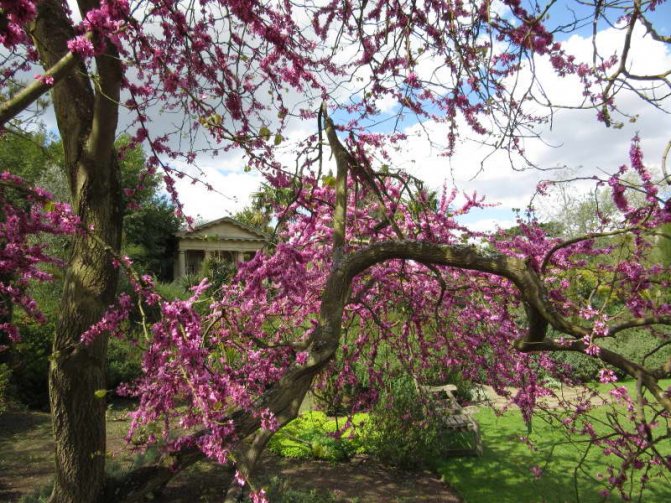

It is a multi-stemmed tree up to 10 m high. Due to its many basal shoots, it looks more like a bush.
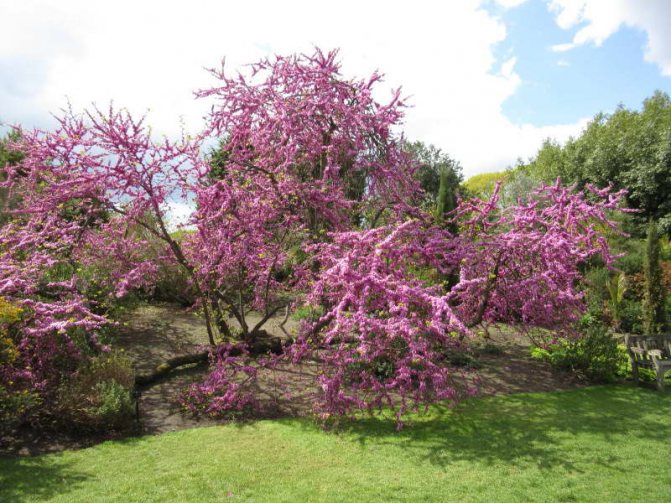

Cercis European Judas tree photo
The crown is spreading, during the flowering period, the twigs are completely covered with flowers of a pale pink hue.
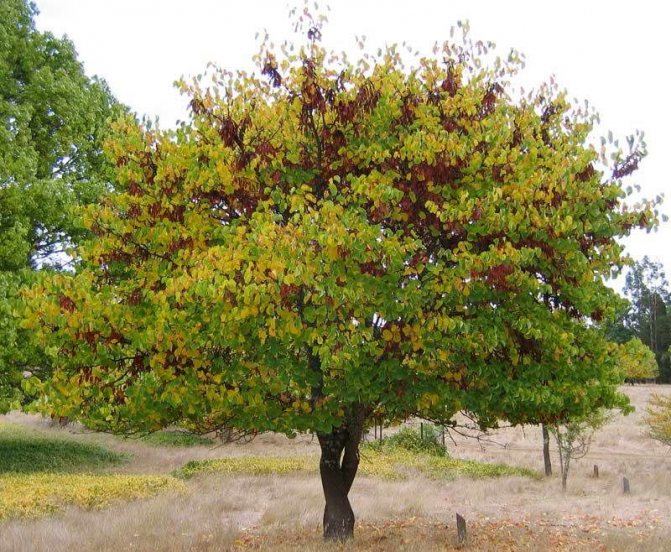

Judas tree in autumn photo
The flowering period lasts 1 month. Then rounded leaves bloom, in autumn their shade becomes bright yellow. Winter hardiness zone 6b, i.e. the plant can withstand temperatures as low as -23 ° C.
Cercis canadensis Cercis canadensis
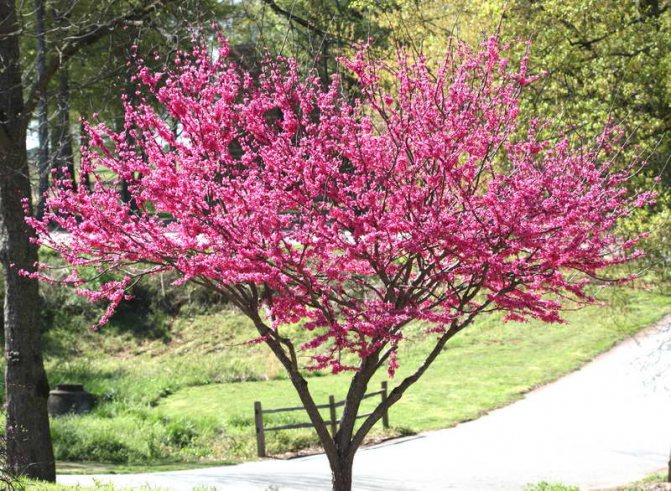

Canadian scarlet or canadian cercis photo
It is resistant to frost and grows successfully in the conditions of central Russia. The height of the tree is 12 m. Light pink flowers are somewhat smaller than those of the previous species, but they quite densely cover the branches and trunk in bunches of 5-8 pieces. Blooms from mid-spring to early summer. The leaves are heart-shaped, their surface is light green, and the reverse side is gray. The pods with beans ripen in August and can hang from the tree for up to two years. This species has white and terry hybrid varieties.
Cercis Chinese Cercis chinensis
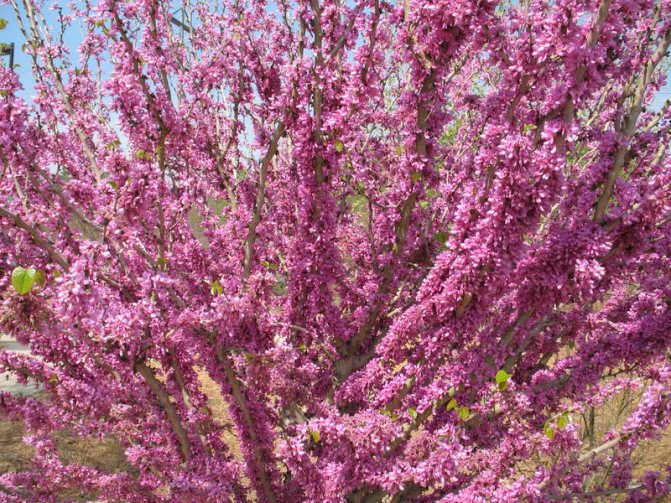

Chinese scarlet photo
Spreading trees 15 m high. Bunches of bright purple-pink flowers bloom in May. Large, heart-shaped leaves that appear later turn yellow in autumn.
Cercis griffithii
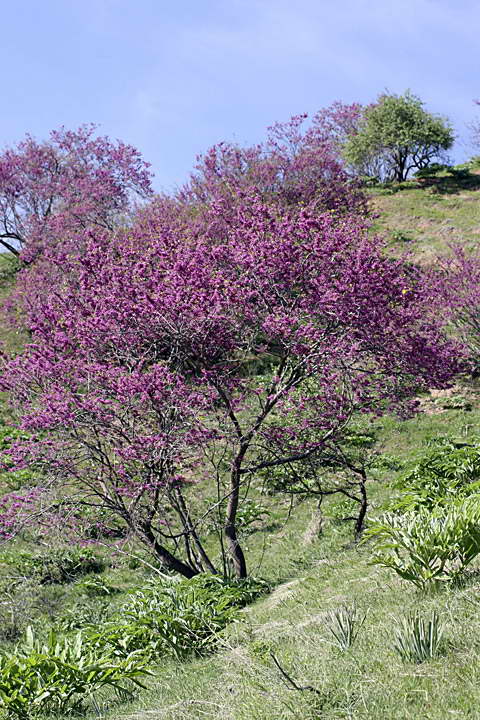

Griffith's scarlet photo
Forms a spreading four-meter bush. Woody shoots. The leaves are rounded with a sharp tip, the surface is leathery, dark green and veined. Corollas of a pink-purple hue are collected in bunches of 5-7 pieces. It does not withstand severe frosts; cultivation is permissible only in regions with a warm climate.
Cercis occidentalis
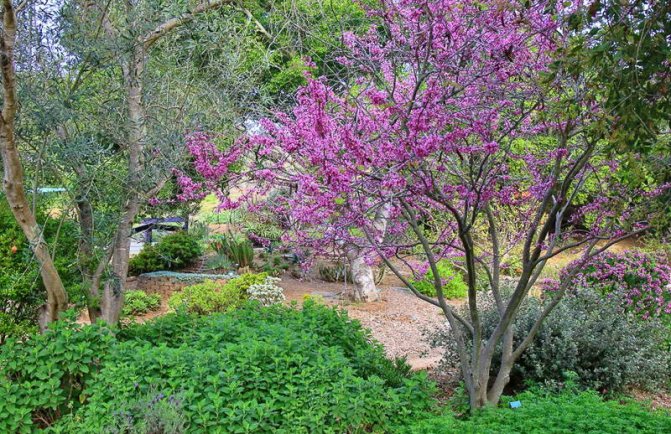

Western scarlet photo
Cold resistance and appearance is similar to the canadian cercis, only in this tree the crown branches more strongly.
Cercis reniform Cercis Reniformis
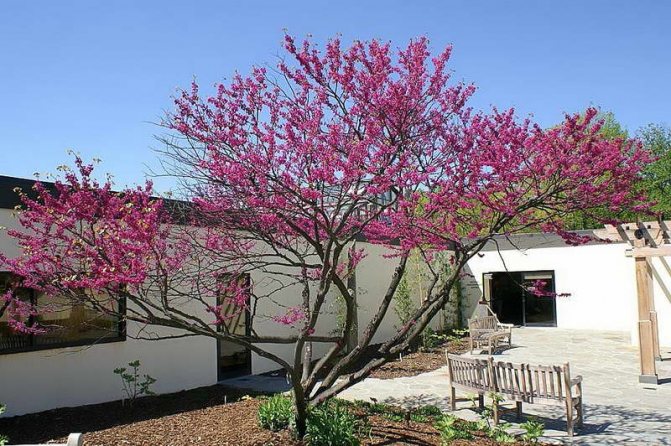

Crimson kidney photo
A tree or shrub with a maximum height of 10 m. Leaves are cordate, dark green, glossy, veined. Heat-loving species exclusively for the southern territories.
Cercis racemosa Cercis racemosa
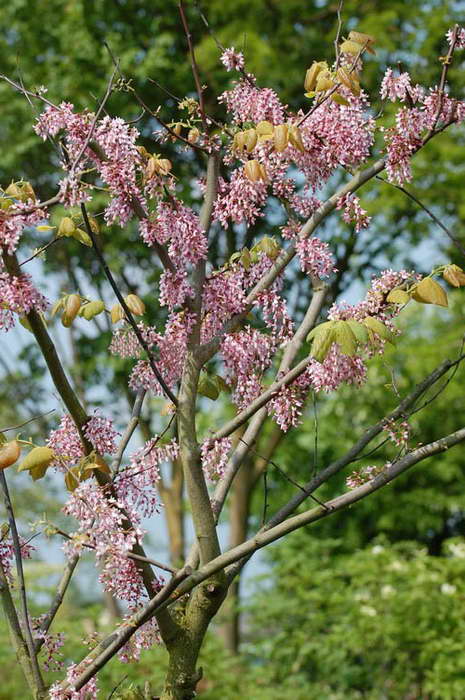

Crimson brush photo
Originally from Central China. A large tree has a spreading crown, dark green leaves turn yellow in autumn. Lilac racemose inflorescences both densely cover the trunk and branches and hang down on short pedicels.
Description
The genus Bagryanik is represented by beautifully flowering deciduous trees or shrubs growing up to 15 m. The crown is tent-shaped. The bark of the trunk is black-brown, covered with cracks. In old branches it is olive-gray, in young branches (annuals) it is smooth with a reddish tint. The trunks are often curved, which gives the appearance of crimson trees a special aesthetics. The leaves are simple, whole, rounded with a pointed tip and a heart-shaped base, the length of the plate is about 8 cm. On the branches they are arranged spirally. The foliage is green in summer and yellow in autumn.
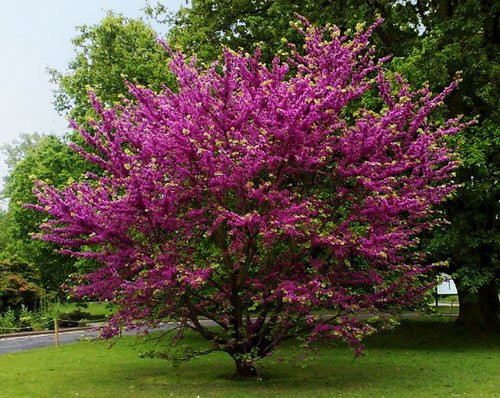

Cercis European
Flowers of irregular (but very interesting) shape, up to 2.5 cm in diameter, are grouped in racemose inflorescences located in the leaf axils. Also, caulifloria is inherent in purple flowers - the development of flowers on the trunks.
The petals are colored pink, reddish or purple, there are five of them, ten stamens. Flowers appear a little earlier than leaves. The flowering process usually begins in early spring and lasts almost a month. The fruit is a flat expanding pod up to 10 cm long with 4-7 rounded smooth seeds inside.
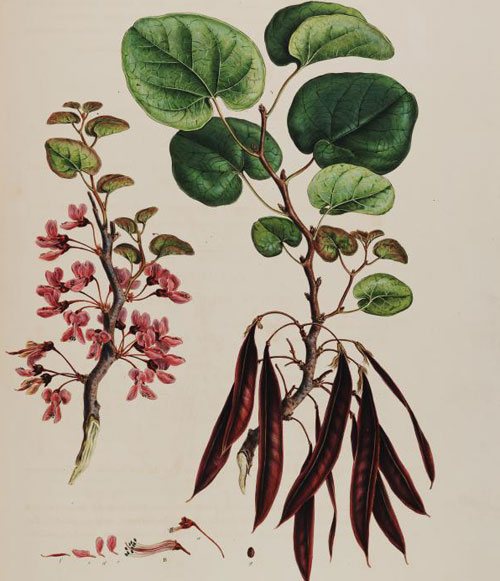

Botanical illustration of Cercis
Description of the tree canadian cercis
Cercis canadensis L. belongs to the Leguminosae family. 7 species of deciduous trees and shrubs belong to the genus Cercis (hereinafter cercis - c.).
Two types: c. Chinese (C. chinensis Bunge) and c. cystic (C. racemosa Oliv), come from the central and western regions of China. Two more species live in the Middle East, in the southwest of the Pamir-Alai, in mountainous Turkmenistan, Iran, Afghanistan, and in the only corner of the Caucasus - the Shvanidzor Gorge.
This is c. Judas tree (C. siliquastrum L.) and c. Griffith (C. Griffitii Boiss.).
Three North American species, c. reniform (C. reniformis Engelm.), c. western (C. occidentalis L.) and c. Canadian (C. canadensis L.) live in the United States, Canada and Mexico.
The name of the genus comes from the Latin word "cercis", which means "weaving shuttle" - probably, two fused lower petals of cercis flowers are similar to this attribute of weaving, or, according to another version, parts of weaving looms were made from wood.
Cercis canadensis or canadian scarlet is a large tree, 12 m in height, with large dark green foliage with a bluish tint, yellow in autumn. The crown is tent-shaped. The bark on the branches and trunk is gray-black, young shoots are red.
As you can see in the photo, the Canadian cercis foliage is wide-oval or heart-shaped, at the very top it is blunt-pointed, smooth:
When describing the Canadian cercis, special attention should be paid to its light pink flowers. They are smaller than that of the European one, but this is compensated by their number: bunches of 5-8 flowers make the shrub stylish and distinctive. In August, the beans ripen, which can hang on the trees for about two years.
A perennial plant usually lives for 50 to 70 years. Shrubs or trees shed their foliage for the winter. Their maximum height is 18 m.
Cercis: a short description of the plant
Cercis can reach a height of 18-20 m. The plant is perennial, lives up to 70 years. On the trunk and large shoots, the bark has a brown-black color with cracks. Young branches are gray or olive brown. Annual shoots are smooth to the touch, reddish shades.
The ovoid foliage is characterized by textured veins with smooth edges. On the branches, they are fixed with petioles, spirally, alternately. The leaves are light green, but darker a little towards summer. Before the leaves appear at their base and in the bark itself, pink buds appear, from which inflorescences develop. Cercis blooms for about 30 days until the foliage fully opens. Flowers are grouped in brushes or bunches, not in the correct shape.
Did you know? The flower corolla of cercis is similar to a moth, and the calyx resembles a bell. Five purple or pink petals, no more than 10 stamens and one ovary make up the flower of the plant.
After the culture has faded, pods are formed on the shrub (length - up to 10 cm), each of which contains up to 5-7 beans. They are flat, oval in shape, with a glossy sheen.
Features of canadian cercis: drought and frost resistance
Certsis is the most frost and drought-resistant species of the genus. It inhabits from New York south to northern Florida, west to Iowa, Texas and northern Mexico. Probably, in the territory of Canada, which gave the name to the species, the wild-growing canadian cercis no longer occurs, the only tree was found in the province of Ontario near Lake Erie. In natural habitats, cercis canadensis grows in mixed forests, along forest edges, on rich soil in lowlands, along the outskirts of bogs, in undergrowth, in woodlands.
Introduced to Europe in the 18th century. According to British dendrologists, in the rainy coastal climate of England, c. Canadian blooms weakly or does not bloom at all, which is explained by the lack of hot dry days necessary for the establishment of flower buds. Perhaps the plant requires a continental climate with hot dry summers for normal growth and development. The frost resistance of cercis canadensis is very high, it is able to withstand cold temperatures down to –29… –31 ° C.
In the XIX century. the species was brought to St. Petersburg, where it died out and was included in the lists of non-frost-resistant exotic species. Currently it grows throughout the North Caucasus, in the Volgograd region, grows and blooms in Voronezh. It is widely grown in Ukraine.In Kiev, trees bloom and bear fruit profusely. Most of the cercis trees growing in Sochi, in the Crimea and in the Krasnodar Territory are c. Chinese or c. Judas tree, not winter-hardy representatives of the genus.
How to care for cercis
The Judas tree does not need much maintenance, but remember that:
- although the culture can tolerate drought, it is still worth watering it on hot summer days (several buckets of water per plant);
- in the spring (best in May), the plant should be fed with organic fertilizer (for example, dilute 1-1.5 cups of slurry in a bucket of water and apply under the bush).
You should also not forget about pruning, proper wintering and protecting the plant from pests and diseases.
Certsis Canadian in the suburbs, Volgograd and Saratov
Currently, Cercis canadian is undergoing the stage of primary introduction in Moscow and the Moscow region. The work is carried out by enthusiasts, amateur gardeners, nursery growers, and plant collectors.
To date, there is not a single message about the trees of the canadian cercis blooming in the Moscow region, but there are several dozen young plants aged 3-5 years grown from seeds or seedlings of Polish or German origin.
Several trees from the Moscow region population have already passed the stages of dying off and restoration of aboveground shoots, their height has reached 1.6–1.7 m. and today, thanks to the efforts of introductors, it successfully grows throughout central Russia, in the Urals and in Siberia. At this stage, gardeners near Moscow need to achieve sustainable growth, flowering and fruiting of winter-hardy specimens in order to select the most winter-hardy and decorative forms in the next generations of seedlings.
In Volgograd planting c. Canadian for over 40 years. Mature plants have survived several severe winters, but have no visible damage, bloom profusely and bear fruit. Sometimes annual shoots freeze slightly, the length of which can reach two meters. Such an intensive growth of shoots is characteristic of seedlings of the first year of life, but with age, the growth of annual shoots comes in line with the climate of the Volga region and the length of the increments does not exceed half a meter, they have time to mature and woody before the onset of frost. Seedlings of Volgograd sertsis grow and bloom successfully in Saratov, where winters are more frosty.
Varieties
In our country, the most common types of cercis are Canadian and European.
Cercis European it is very decorative. In spring, its branches turn almost completely pink due to the abundant flowering. The plant is thermophilic, does not tolerate prolonged frosts, therefore it is suitable for growing in the southern regions. Most often it grows in the form of a tree, but due to the basal shoots it can look like a large shrub. The height of an adult plant can reach 10 m. The trunk is thick, the crown is spreading, the leaves are semicircular. In autumn, the leaves turn bright yellow. Flowers appear in early spring before the leaves open and wither after a month. The color of the petals is bright pink.
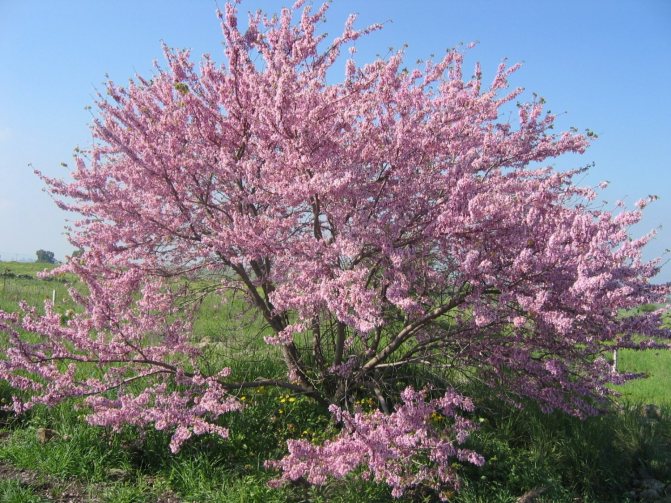

Cercis Canadian more common in the northern regions and is resistant to severe frosts. The trees are taller than the previous species and reach 12 m. The foliage is large, heart-shaped, green above and bluish below. Smooth leaves turn yellow in autumn. The light pink flowers are smaller than the European variety and cover the stems less densely. But still, the branches and even the trunk are covered with dense bunches of 5-8 flowers. Flowering begins somewhat later and lasts until the beginning of summer. The beans ripen in August and do not fall off for a long time, some of them remain for two years. This species has two hybrid varieties:
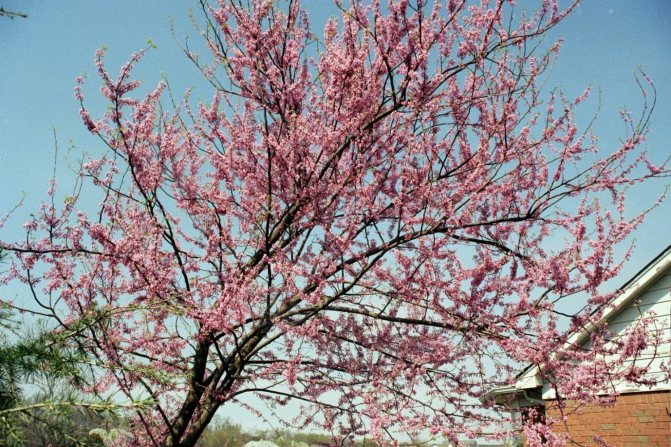

Cercis Chinese represents very tall (up to 15 m) trees with large heart-shaped leaves.The plant is thermophilic and does not tolerate frost. Bright purple-pink flowers are gathered in large bunches, which make the tree very elegant in May.
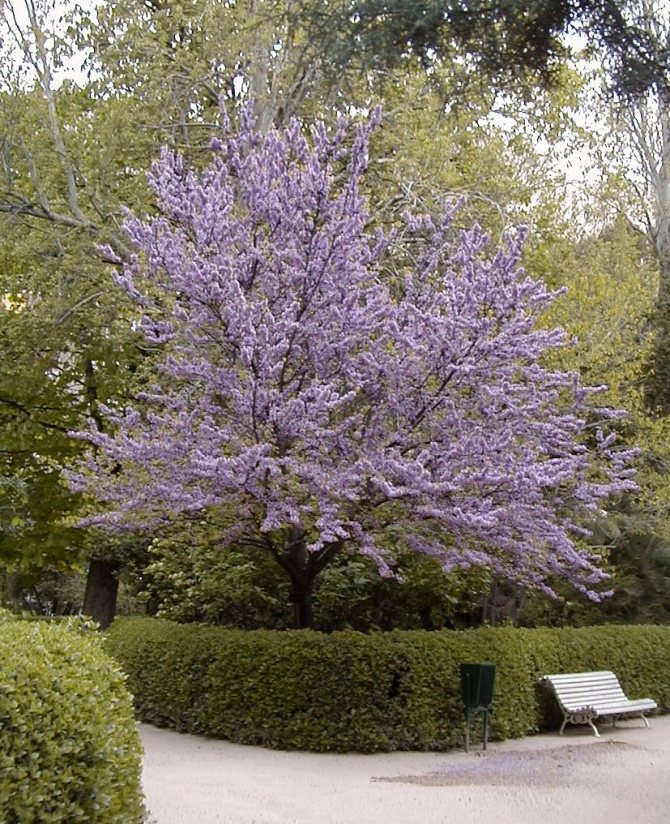

Cercis Griffith unlike previous species, it forms a tall shrub with stiff shoots. Plant height reaches 4 m. The foliage is round, dark green, leathery. Flowers are collected in clusters of 5-7 pieces and have a pink-purple color. Does not hibernate in temperate climates.
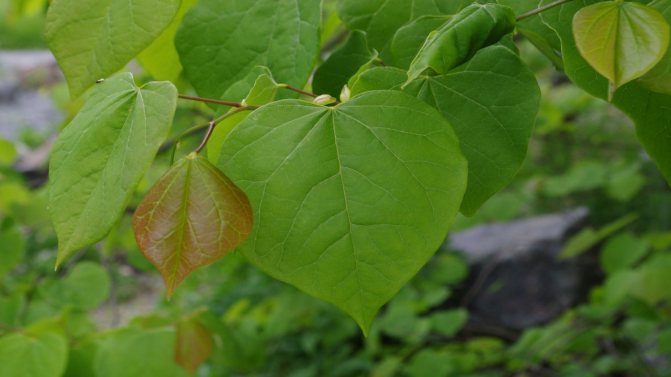

Cercis western... The frost-resistant trees are characterized by a highly branched crown and bright green foliage. The rest of the species is similar to the Canadian one.


Cercis reniform develops in the form of a large shrub or tree with a maximum height of 10 m. The plant is thermophilic, differs in the shape of inflorescences. The buds are collected in small drooping racemes on shortened pedicels. The length of the inflorescence is about 10 cm. The color of the flowers is bright pink. The foliage is oval, smooth, dark green in color.
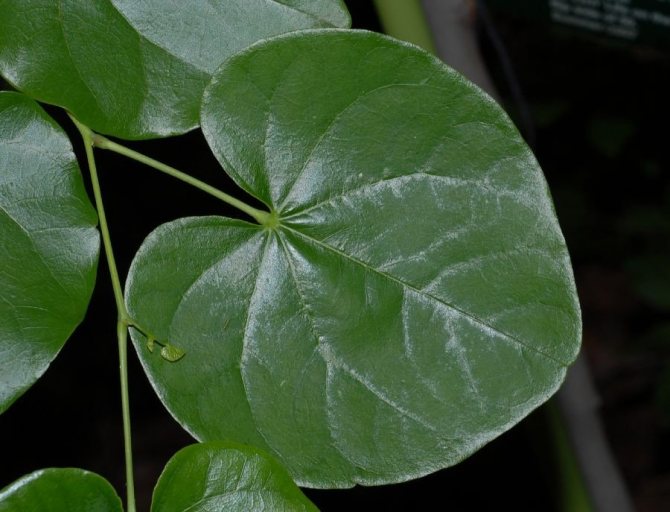

Cercis cystic lives in the central part of China. A large tree with a dark green crown in summer and yellow leaves in autumn. In spring, it blooms in purple. The buds are collected in large clusters, both tightly sitting on the branches and trunk, and falling on short pedicels.
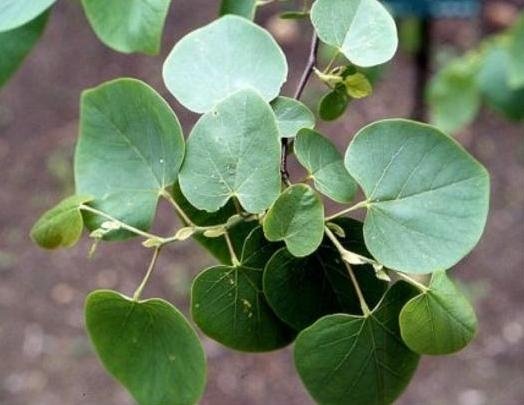

Planting and caring for Canadian cercis
Cercis easily tolerates pruning, branches abundantly, forms replacement shoots from dormant buds. It is necessary to plant cercis in an open, sunny place, but with protection from northern winds.
Enthusiasts usually use two sources of viable c. Seeds. Canadian. Most often, the source of seed material is the trees of the Kiev population. The well-known plant collector and introducer Vladimir Milyaev from Voronezh notes that when sowing Kiev seeds, part of the seedlings turns out to be non-resistant, some are moderately winter-hardy, and some are completely winter-hardy. Winter-hardy seedlings obtained from Kiev seeds in Voronezh by the 8th year reach a height of 2.8 m, bloom profusely, but do not set fruit.
The second source is seeds imported from Canada and the United States. Their origin is unknown, but the probability of obtaining genetically diverse material for further introduction seems to be very useful and interesting. In Voronezh, seedlings from seeds of Canadian origin bloom from 6-8 years.
Cercis seeds require scarification for germination. You can also treat the seeds with sulfuric acid. Without treatment, the seeds germinate uncommonly and gradually germinate over 5 years. After scarification or treatment with sulfuric acid, 80% of the seeds germinate immediately. Seedlings grow quickly, especially when sown in open ground, but they do not tolerate transplanting well. Experienced gardeners recommend sowing seeds in containers 25-30 cm high with a sandy loam soil mixture, and leaving the seedlings in them for 2 years to form a dense root system. During cultivation, several mineral dressings are carried out. When transplanting young plants from containers to a permanent place, the sandy soil easily crumbles from the roots, so the separation and planting of seedlings takes place with minimal damage. Seedlings bloom in Volgograd already in the third year, but lush flowering should be expected only from adult plants with a formed crown.
According to the reports of Moscow gardeners, even with good care of the Canadian cercis, the seedlings grow slowly after planting for the first 3-5 years. In the first year, the plants reach a height of 40–50 cm, but during the winter all the shoots or most of them freeze to the ground. In the second year, shoots grow from the dormant buds from the root collar, reaching 80-100 cm in height. Often they freeze over the winter. In the third year, the regrown shoots reach a height of 140–160 cm. Such an unusual rhythm of shoot development in young plants is explained by the predominant development of the root system to the detriment of the aboveground part.In the first year, the roots of the seedling reach a depth of 45 cm, in the second year they deepen to 1–1.5 m, and from the third year a deep (more than 2 m) and wide horizontally spread root system with a diameter of up to 6–8 m begins to form. For this reason, cercis seedlings must be immediately planted in a permanent place, since the plants do not tolerate transplanting and root damage poorly. It should be noted that intolerance to root damage is characteristic of most members of the legume family; it is especially pronounced in drought-resistant species.
Pruning purple
Autumn pruning is formative. If necessary, the branches are shortened by a third of the length, the emerging root growth is also removed, as well as all deforming branches and those that are knocked out of the general picture. Simply put - we get the desired crown shape.
It is worth noting that due to the slow growth of the plant, formative pruning is carried out annually only for the first 3-5 years of growth, and then practically stops. The only pruning is the damaged branches, the so-called sanitary pruning.
In the case of planting other plants next to the purple, it must be remembered that its root system develops in such a way that at first it deepens by about a meter, and then diverges along a horizontal plane to the sides. For this reason, you should not place any other plants in the immediate vicinity of the tree.
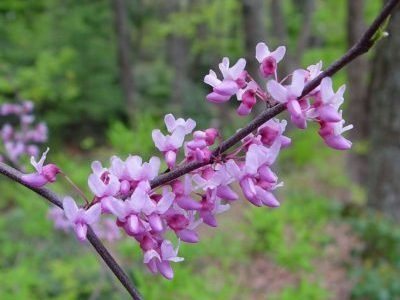

Location of cercis
It is quite easy to create good conditions for growing cercis.
Despite the fact that a light partial shade will be the best option for placing the scarlet, it is able to adapt to the bright sun. Additional lighting will be especially useful for the crop during the cold season.
The main requirements of cercis to the soil are good drainage, looseness and the presence of lime. But the plant can grow on most soils in the middle lane. Only in very clayey soil can a little sand be added to it, thus improving drainage.
Cercis plants are planted in a sunny place with drained soils.
Cercissus canadensis
It has rather small lilac flowers. But there are so many of them that the branches are simply strewn with them. They are collected in inflorescences, which have up to 8 flowers. It is characteristic of this tree that flowers appear even on thick and old trunks, thanks to which it looks very impressive. There are double and white-flowered varieties of Canadian cercis.
This tree is quite frost-resistant, and therefore it is successfully grown in the south of our country, up to the Voronezh region. A little further north (in the Lipetsk region), this species freezes over, and therefore does not bloom too abundantly. Well, in the Moscow region, the Judas tree, the photo of which you see in this article, is unlikely to reach its full splendor.
Distribution and ecology [edit | edit code]
The natural range of the species covers the Mediterranean, the Near (without the African part) and the Middle East, in Russia it grows on the Black Sea coast of Crimea (in the region of Yalta, Alushta) and the North Caucasus (from Gelendzhik to the Adler region of Sochi), as well as in Abkhazia. [5] [6].
It grows on stony slopes, usually on a lime-containing substrate.
It grows slowly, at 4-5 years it reaches a height of 1-1.5 m. At 100 years old it reaches a height of 12.5 m with a trunk diameter of 50-60 cm and a crown up to 10 m in diameter.
Transplant and reproduction
You need to replant the Judah tree as needed and preferably in early spring. This procedure must be carried out very carefully so that as many roots as possible are preserved.
Trees can be propagated by seeds and cuttings. Seeds must be kept in the refrigerator for a week before planting. Then they need to be soaked in water for 24 hours.
When planting, the seeds do not need to be buried too deeply, because they germinate only in the light. The container with the crops is covered with glass on top and taken to a bright place. The optimum temperature for seed germination is between 20 ° C and 23 ° C. The first shoots appear in about 4 weeks.When young plants are 10 cm tall, they can be planted in separate pots.
Cuttings are best propagated by the Judas tree in summer. Shoots are cut into a length of at least 15 cm. They are planted immediately into the soil, deepening 5 cm in depth. They take root in 4-6 weeks.
And brushy), two - in the Mediterranean, in Altai in Afghanistan and Iran (European and Griffith), three representatives of the family are from North America. Under natural conditions, the tree reaches a height of up to 30 meters. The last three species are quite cold-resistant, therefore they are successfully grown in some regions of our country.
Why is the tree called that?
Probably, many are interested in why the plant was named so. Cercis, the scarlet, or Judas tree, is called so because, according to one of the legends, on this tree the repentant Judas took his own life. True, different peoples have their own version of this story, while the most different trees appear in it - aspen, elderberry, birch, rowan. But for some reason, it was cercis that was nicknamed that way - the Judas tree.
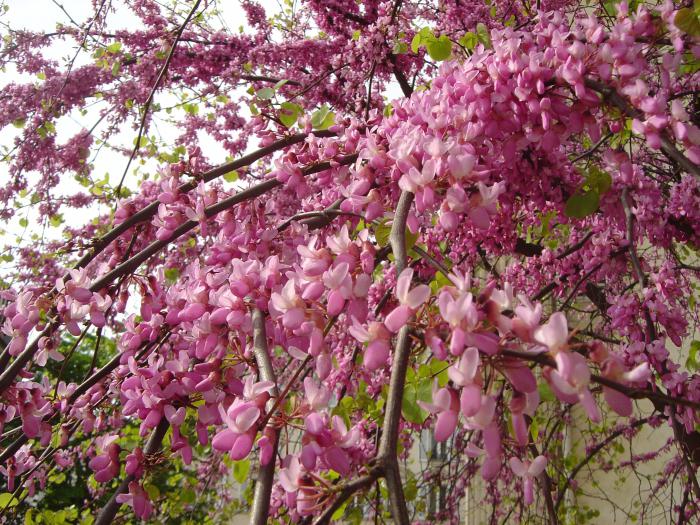

Features of the tree
Cercis has cordate, slightly rounded leaves. They are green on top, smooth, and the underside is glaucous. Young, newly emerging leaves have a reddish tint, which changes to light yellow in autumn. First, flowers appear on the tree, and only then leaves. Flowers remain on the tree for twenty days, by which time the leaves are already opening. Flowers of extraordinary beauty - delicate, can be painted in a light lilac or more intense shade. They have a standard form for legumes.
The Judah tree, the photo of which is presented in this article, has a fruit - a brownish flat bean about 10 cm long.On the tree, they last up to two years.
Judas tree as a honey plant
Cercis European is an excellent honey plant. Many amateur beekeepers plant this tree in their private apiaries. The bright flowers of cercis attract bees, and honey obtained from the pollen of the flowers of the Judah tree has many beneficial properties. Cercis honey is quite rare on the market. It has a thick consistency and golden brown color. Beekeepers note its high taste: honey has a pleasant, slightly tart taste, with a bright floral aroma. The honey of the Judas tree, just like the leaves of the plant, is rich in useful bioflavonoids. He has the following beneficial properties:
- Stops chronic and acute inflammation;
- Destroys pathogenic bacteria and expels parasites from the body;
- It is used in the treatment of diseases of the upper and lower respiratory tract (bronchitis, pneumonia, laryngitis and tracheitis);
- It has a beneficial effect on digestion and stimulates metabolism.
In order to get a sufficient amount of honey from cercis, several trees should be planted in the apiary, in different places or together, in a group.
Use of cercis
Fortunately, there are several species of exotic cercis shrub that grow and bloom in colder climates. These brightly flowering plants can be very beautifully combined with conifers in group compositions. Crimson also looks spectacular in single plantings. It can be used to transform and decorate any area. Also hedges and cercis alleys look very picturesque.
- In cooking, spicy spices are prepared from the buds of cercis for various dishes. The wood of the European type of scarlet is used in carpentry work.
- The bark of the plant is also used for medicinal purposes by Chinese healers as an antiseptic.
- The type of plant western cercis is used to obtain a reddish dye for dyeing wickerwork, which the craftsmen weave from its own thin twigs.
- In indoor floriculture, using the characteristic of the slow growth of scarlet, the plant is used in the art of bonsai.
Name history
When domestic gardeners are asked what a Judas tree is, many answer as follows: "This is an aspen on which Judas hanged himself." However, this is generally accepted only in Russia. In Western Europe, the name "Judah's Tree" (in English it sounds like "Judah's Tree") refers specifically to Cercis. There are two versions regarding the origin of this interesting name. The first version claims that cercis was one of the most common trees in ancient Judea (on the territory of modern Israel and Palestine), hence the name - "Judah").
However, there is another version of this unusual name. It dates back to biblical times. The Gospel says that one of the apostles - the first disciples of Jesus Christ - was Judas. Unlike other disciples of Christ, he did not have sincere faith in him. Judas differed from his comrades in such negative character traits as:
- Selfishness;
- Deceit;
- Passion for profit;
- Readiness for meanness and betrayal.
Gardeners reviews
loo1:
“Sergey, in general, he is growing rapidly, this is my 2nd year, I took it quite small, it grew 2 times, it blooms for the 2nd year too, but this year there are more flowers. So, I think in a year or two yours will bloom. But, it will bloom profusely, only in adulthood. He, I still try to grow as a bush, gives growth from the root, but I remove it so that it is a tree. In our region, the temperature in winter is different and -15-20 degrees, and it was -27-28 degrees, but only about a week. And nothing happened to him. Not far from me, a 3 m high cercis grows. "
Source forum-
Irina:
»I have 2 cercis growing. One tree and one grows as a bush. The tree has bloomed this spring. But the flowering is still not very plentiful. And I just want to buy the scarlet. In scarlet, the leaves are opposite. So you can immediately distinguish a seedling from a cercis. Certsis never covered and does not freeze at all ... I'll try to look for a photo of my tree. "
Administrator:
“While vacationing in Miskhor I drew attention to this interesting tree, which grew by self-sowing throughout the territory of the sanatorium. Indescribable beauty! Distinct veins are visible on large, rounded leaves. Flowers are located along the entire length of the shoot, pink, slightly similar to pea flowers. I collected several stitches with already ripe seeds, tried to germinate, but nothing came of it. And you? I know that it hibernates with some gardeners even in Kharkiv, though they form it in the form of a bush and not a tree ... And yet, a question for connoisseurs, cercis and scarlet, are they the same thing or not? "
Growing in Russia
In the Moscow Botanical Garden, the Judah tree reaches 7 m in height. In St. Petersburg, you can even find magnificent purple, which tolerates the cold worse than other species.
This tree loves light. But at the same time it is able to live in partial shade. Prefers a northern side and a place protected from the winds. The tree should be planted in early spring, so that it takes root before the onset of cold weather. The scarlet is unpretentious to soils, but weakly acidic loam or sandy loam is most suitable for it. The soil should be light in structure, this will allow the root system to develop freely. Numerous superficial roots add wind resistance to the tree. The scarlet plant does not really like transplanting, this is due to the fact that the plant has a taproot.
The scarlet loves moisture. Poorly tolerates extreme heat, during a drought it often sheds leaves. It takes root well near water bodies, along the banks of rivers. The site for planting should be well-drained, not have high groundwater.
General characteristics and types
Any gardener dreams of growing this exotic culture on his site. The genus Cercis is represented by thermophilic, deciduous shrubs and trees with stunningly spectacular and picturesque flowers, having a lush, spreading crown, shaped like a ball or a tent. Barrels are often irregular, curved, or one-sided. Cercis, or scarlet, belongs to the legume family.
The culture is not very diverse. There are only seven of them:
- Certsis (scarlet) Chinese (C. chinensis Bunge.) Grows in China, its central and western parts.
- Certsis (scarlet) cyst (C. racemosa Oliv.) Lives in the central part of China.
- Cercis European (Cercis siliquastrum L.), or ordinary purple, grows in some regions of the ancient Mediterranean, in the southwestern part of the Pamir-Altai, in the mountainous regions of Turkmenistan, in Afghanistan, Iran and in the Shvanidzor gorge located in the Caucasus. It is this species that is called the Judas tree.
- Certsis (purple) Griffith (C. griffithii Boiss.) Grows in the same places in which the European cercis lives.
- Reniformis Engelm. Native to North America.
- Certsis (purple) western (C. occidentalis Torr.) Also lives in North America.
- Certsis (scarlet) Canadian (C. canadensis L.), like the two previous species, grows in North America.
The first four species are very fond of warmth, so their cultivation in cold climatic zones is problematic. The last three species are more hardy and able to withstand light frosts. Cercis, or canadian scarlet, exhibits the highest frost resistance.
Japanese scarlet
At home, the Japanese scarlet is called Katsura. An ancient legend says that a Chinese monk learned the secret of eternal youth. He felt invulnerable and immortal. As he believed, this gave him the right to commit the most terrible crimes. For his actions, he was sentenced to exile on the moon. Not reaching her, the monk fell to the top of the Katsura tree. Since then, it has become the embodiment of an unrealizable or unattainable dream.
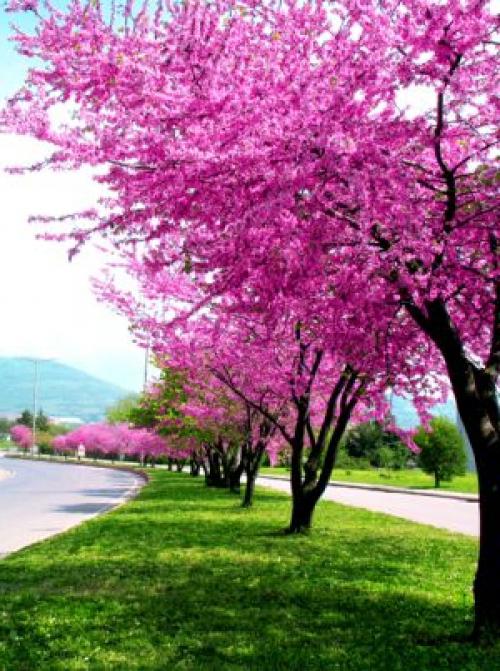

The scarlet tree, or Judah tree, is used as an ornamental deciduous tree, it has a bright shade of leaves in the shape of a heart. This color becomes especially saturated in autumn, when the tree is colored with crimson and yellow colors and looks truly magnificent. Very bright brown-carmine shoots give it a special originality.
Today, the Japanese scarlet, or Judas tree, is quite widespread and very popular in Europe, where it was first introduced in 1880. Later, new decorative forms appeared - Rotfusch with a funnel-shaped narrow crown and gray, heavily wrinkled foliage, Pendulum with weeping branches, and others.
Beneficial features
Doctors and biologists say that the leaves of cercis contain flavonoids - substances that have antibacterial and anti-inflammatory effects. Bioflavonoids, which are found in the leaves of cercis, kill Koch's bacillus (this is a microorganism, which is considered the causative agent of tuberculosis) and contribute to the healing of pulmonary tuberculosis and bone tuberculosis.
The healing properties of cercis were also known in ancient China. Chinese used plant bark for external use. Local healers believed that the cercis bark has an antibacterial effect, relieves inflammation and disinfects wounds. The bark of the plant, ground and pounded into powder, was applied to open wounds, abscesses and ulcers. It was believed that this contributes to the early healing of the wound surface.
Care
At home, the Judas tree is grown in a warm and bright place. A south-facing balcony or terrace is best suited for these purposes. Young trees in the afternoon should be protected from direct sunlight.
You need to water often. Between waterings, the soil in the pot should only dry out a little. Prolonged drought, like waterlogging, is equally harmful to this plant. For irrigation, you can use only rainwater or water purified through a filter.
The European scarlet does not need annual pruning. It is carried out as needed in spring or autumn. Too long branches are shortened by a maximum of a third. Dried and diseased ones must be cut off completely.
The Judas tree should overwinter in a bright and cool place.The air temperature at this time should be from 7 ° C to 15 ° C.
Reproduction of Tersis
The Judah tree is propagated by seed and cuttings. Stratify the seed for 3-3.5 months before planting. To do this, place the seeds in the refrigerator, cellar, basement, or balcony.
Immediately before planting, soak the seeds for 24 hours in a container of hot water. The shell will soften, which will increase the number of seedlings.
Freshly harvested material can be planted before winter in high beds with loose rocky soil. A large percentage of germination of seeds stored in pods on a tree all winter.
In June - July, cut cuttings with 2-4 live buds from the tree. Plant the shoots in a mixture of humus and sand, moisten the soil daily. Do not repot the plant for 0.5-1 years, a weak root system may deform and die.
If you do not cut the center conductor, the tree will form into one trunk. If removed, lateral shoots are formed, forming a sprawling spherical crown.
How to plant
Before planting a shrub, you need to choose an open and well-lit area of land. He will be comfortable where the south is, that is, the place should be bright and warm. It does not tolerate drafts, the earth should also be lime and oxygenated.
Growing plants is best done from seed, as cuttings will not grow well in harsh climates. Before planting seeds, they must first be soaked. And to prevent fungal diseases, you can pre-treat them with a fungicide.
Before planting a seed, the soil must be well loosened. It is necessary to plant seeds in winter to a depth of several centimeters. Then it needs to be covered with something, for example, fallen leaves.
This is necessary for insulation, the plant will grow slowly and the upper shoots will often die off. After 3 years, they will get stronger and will reach 20 cm in height.
